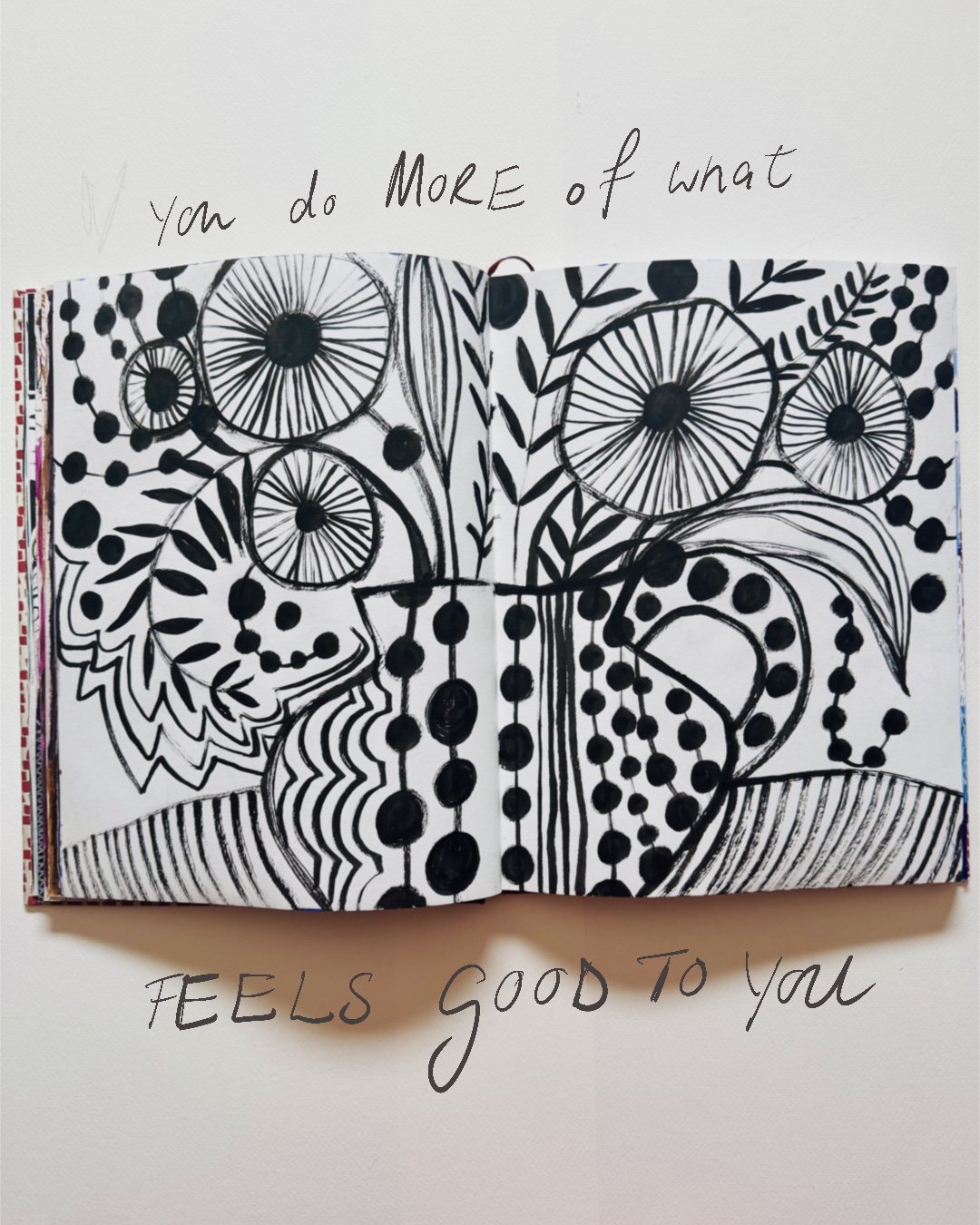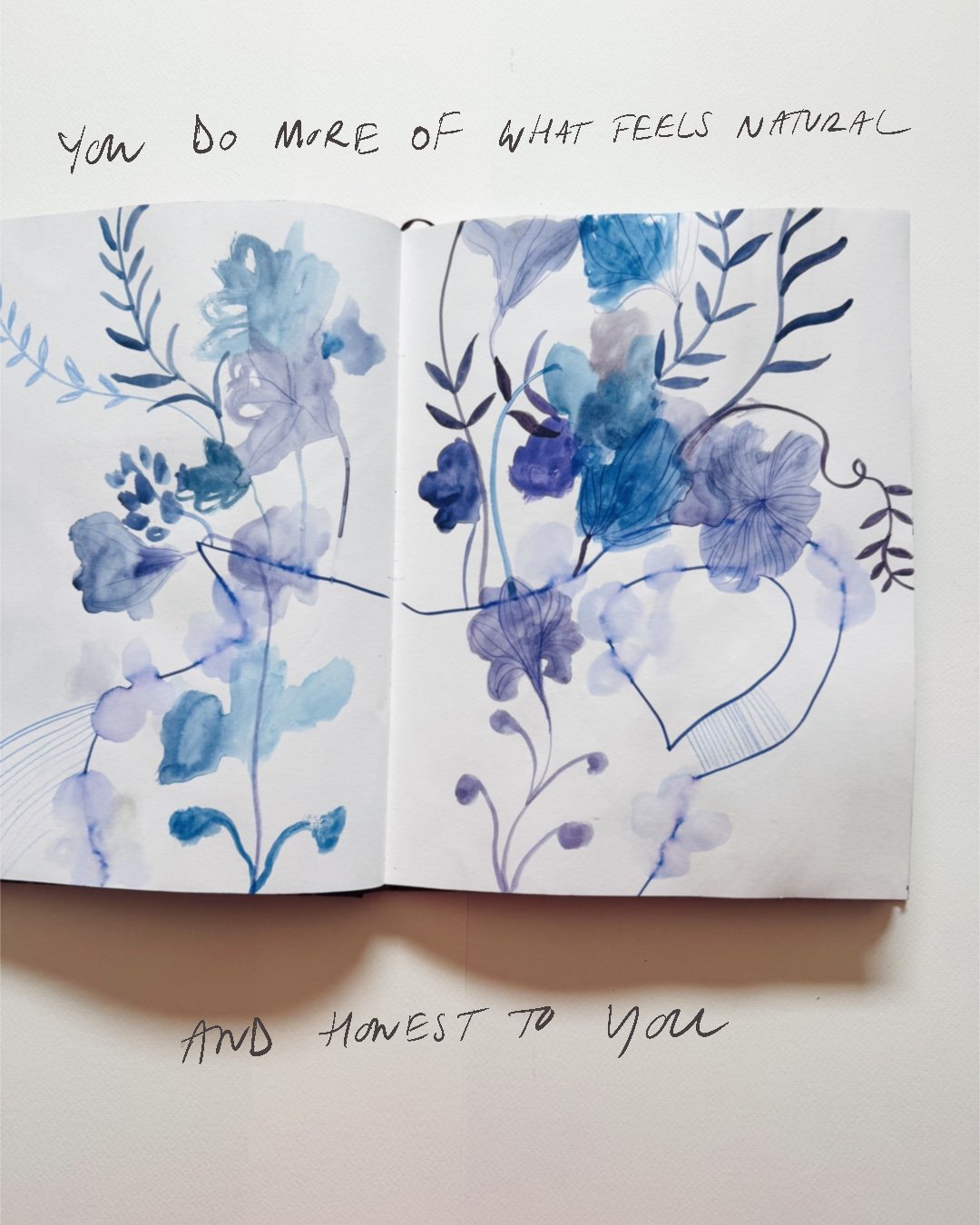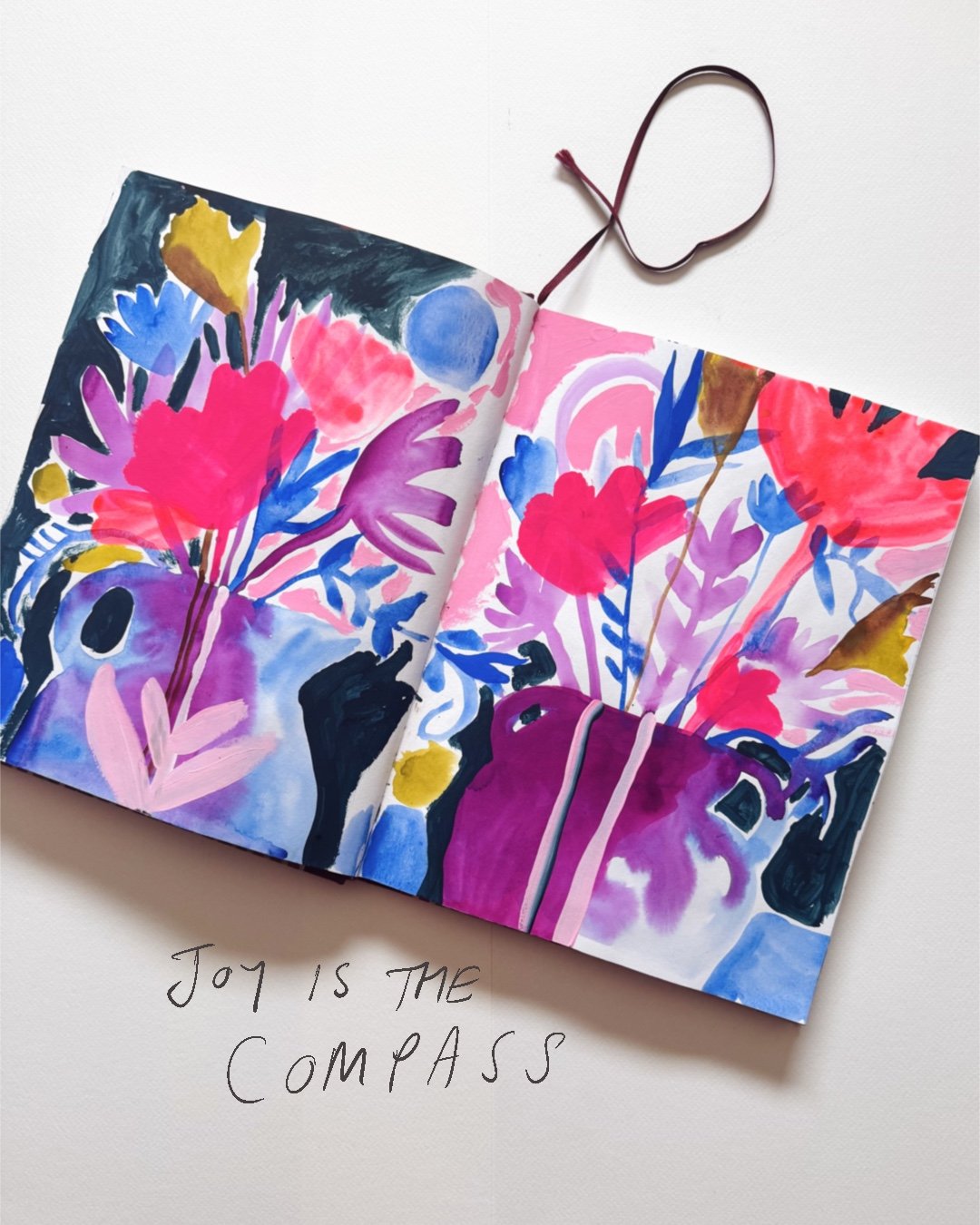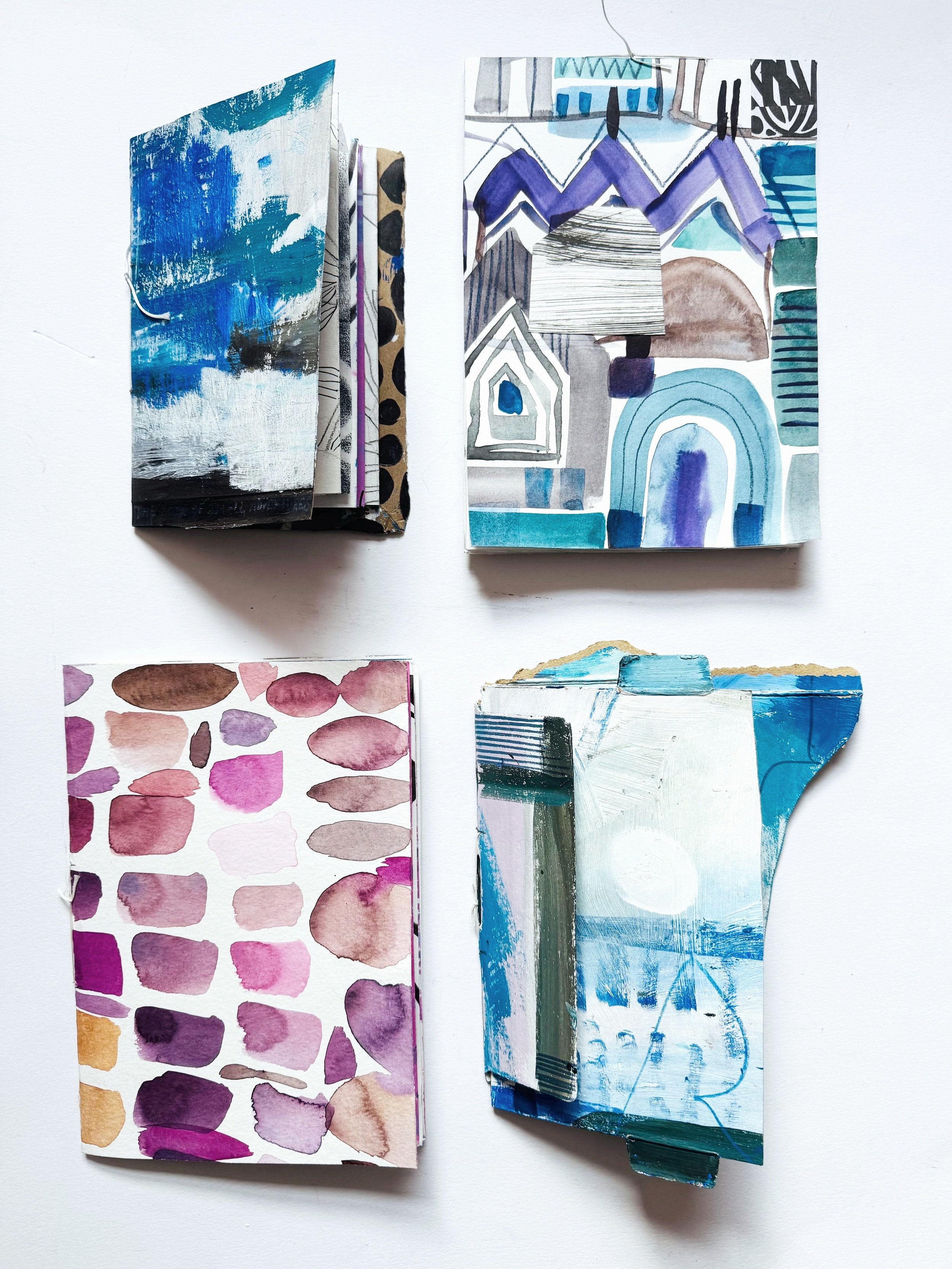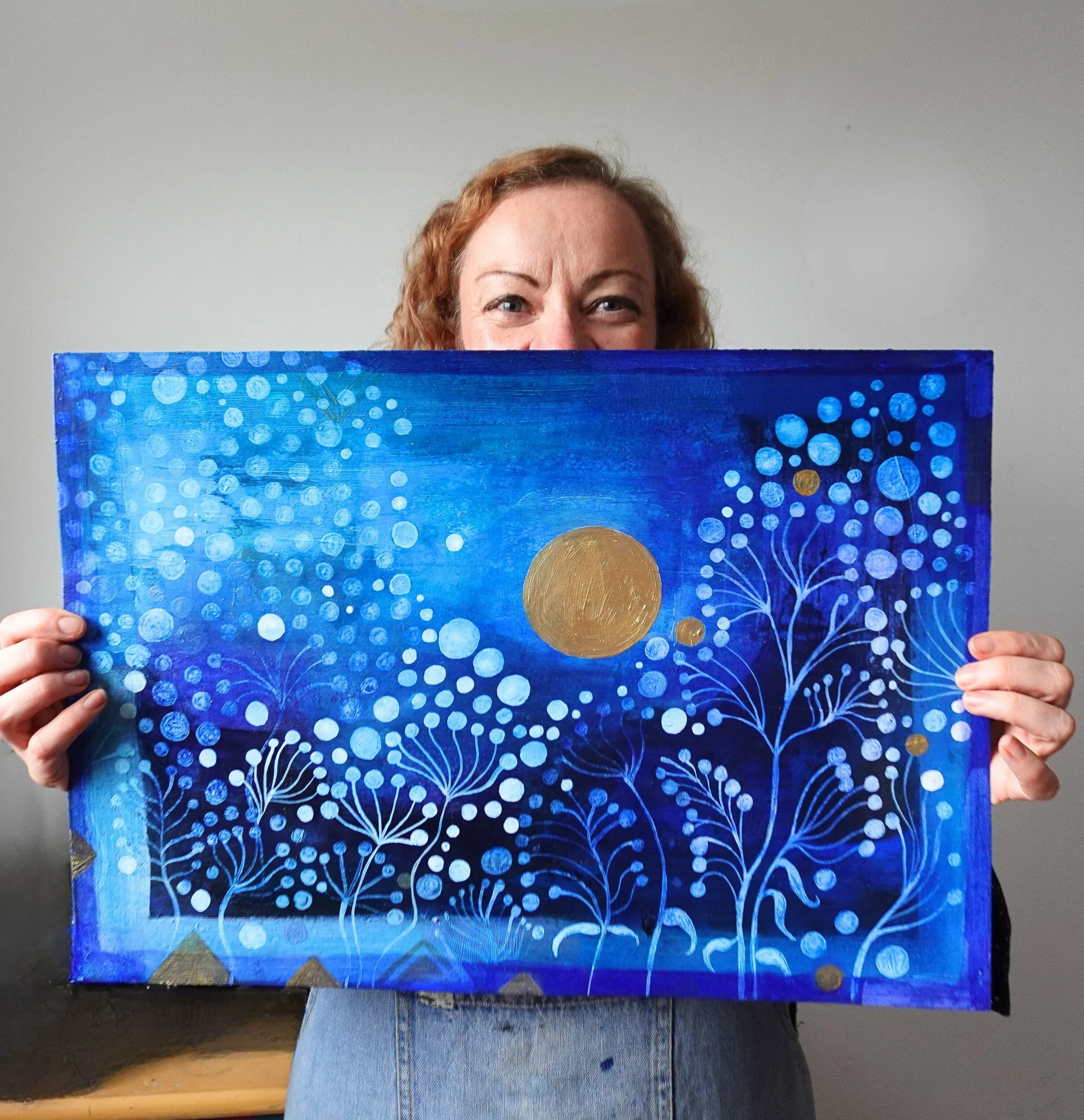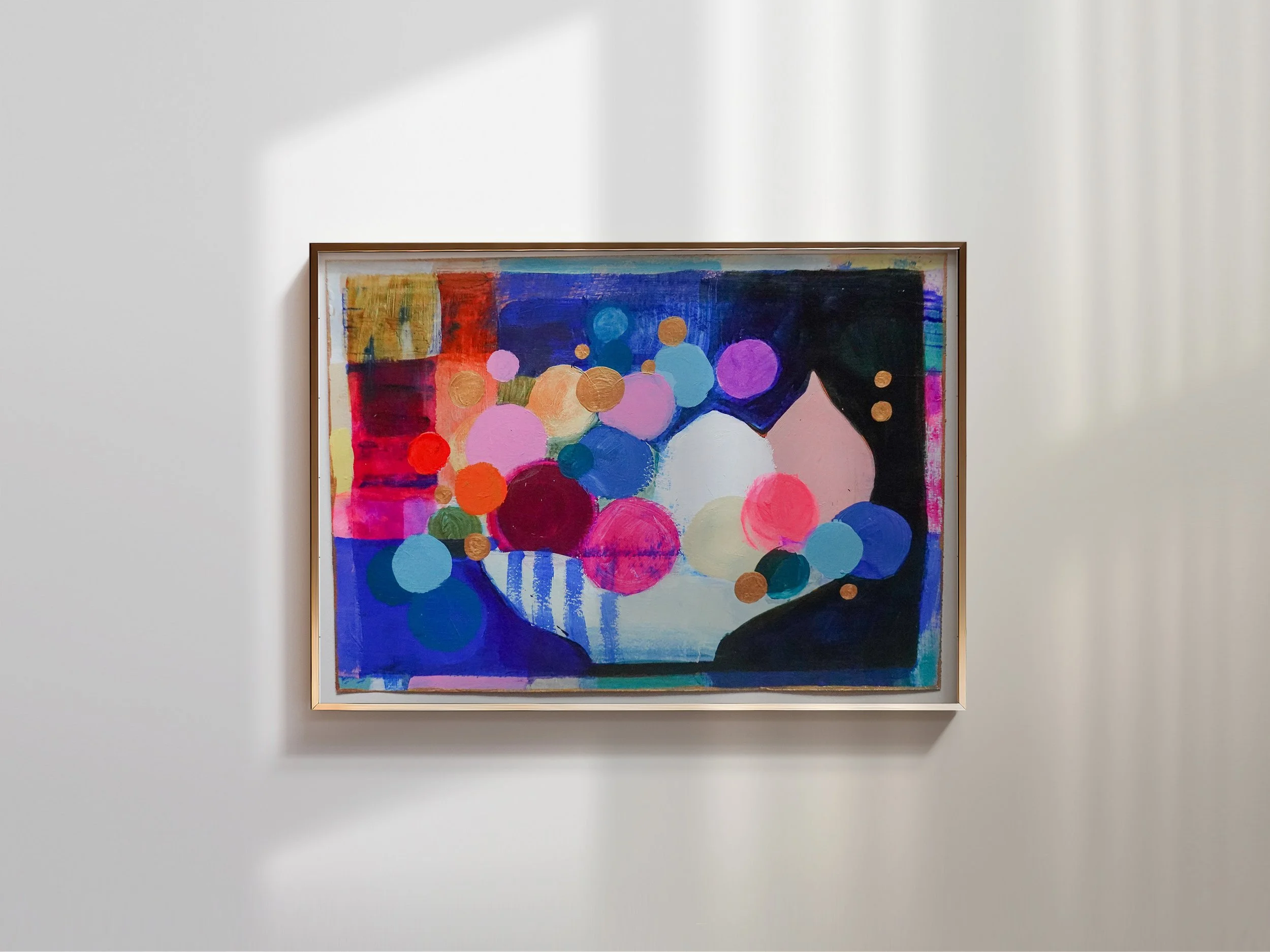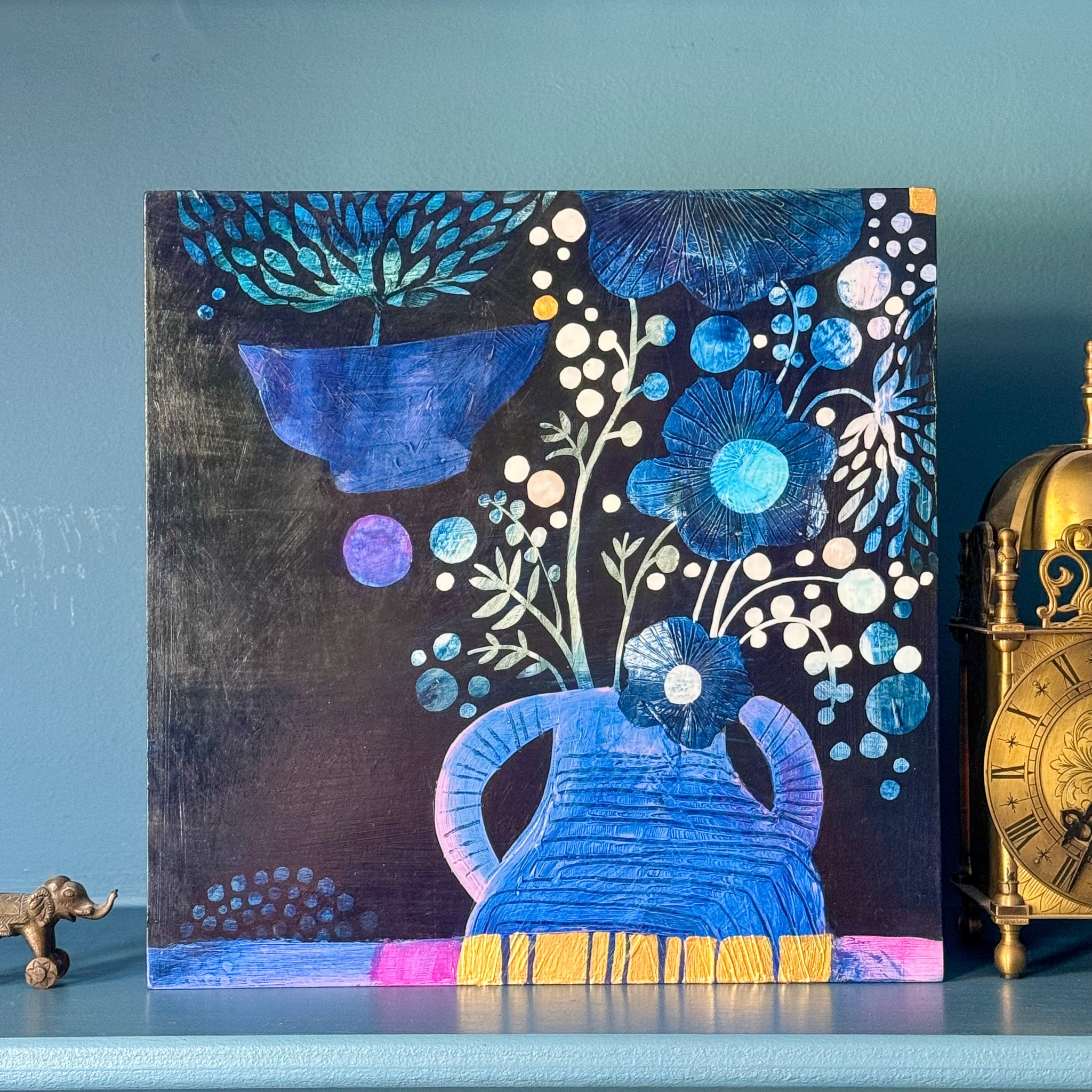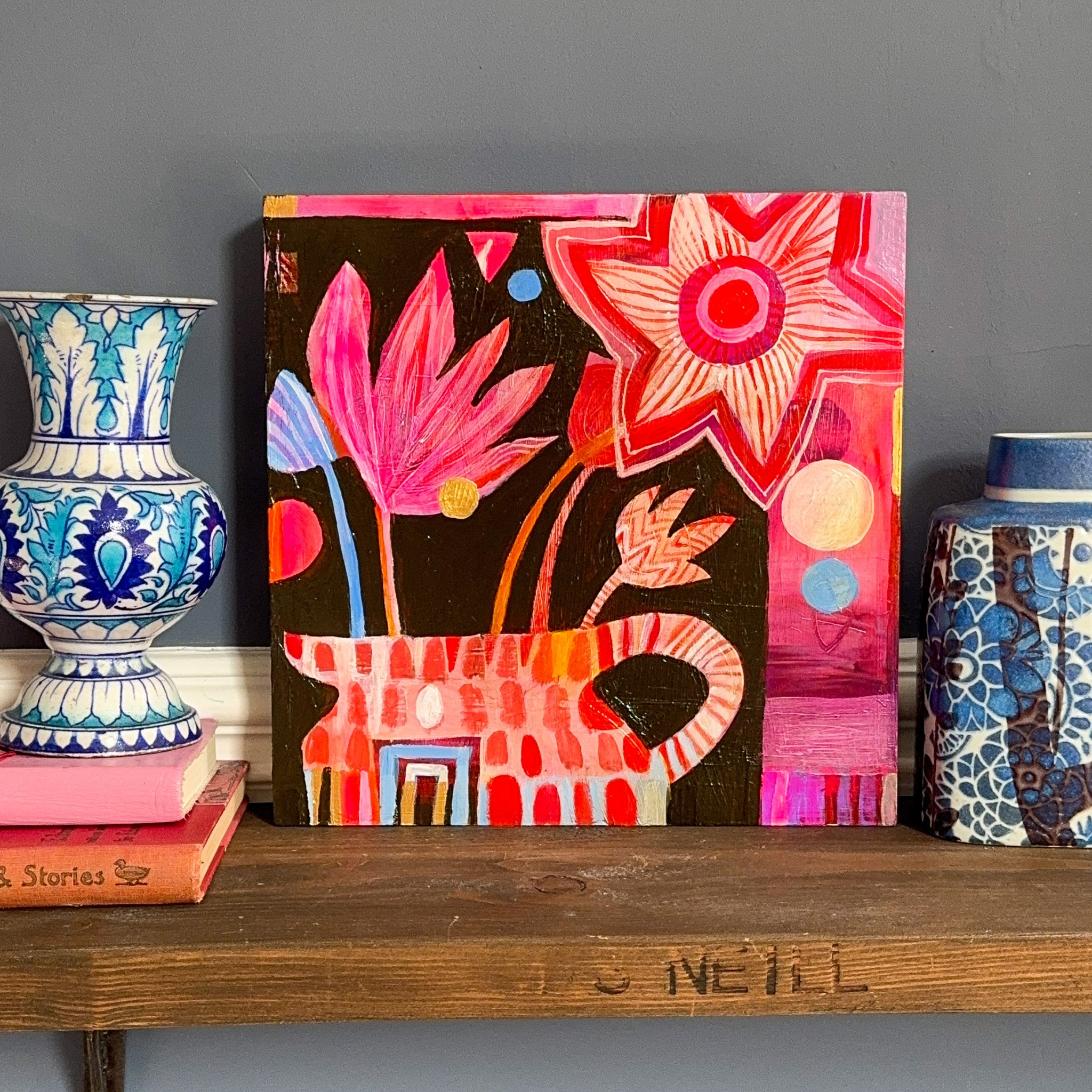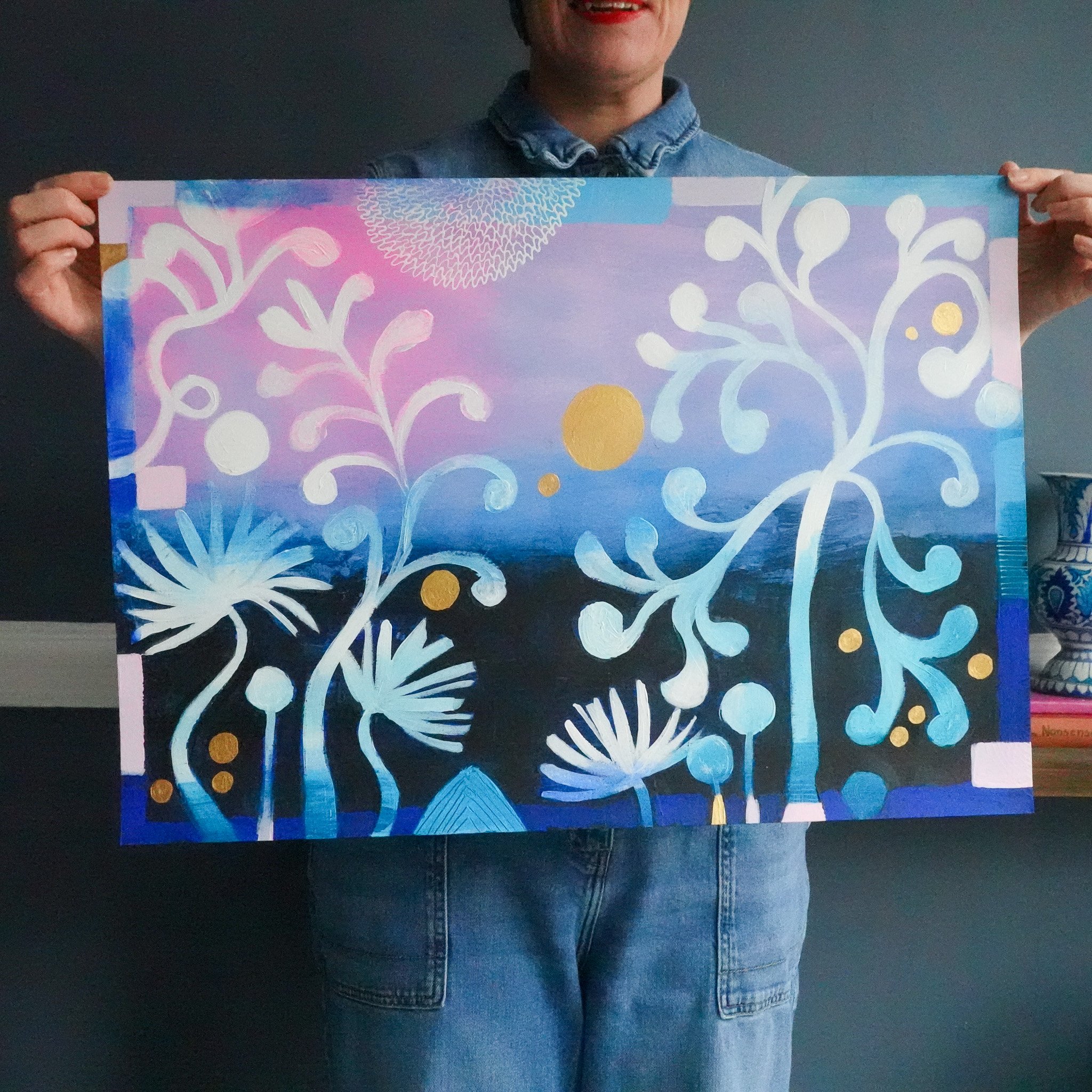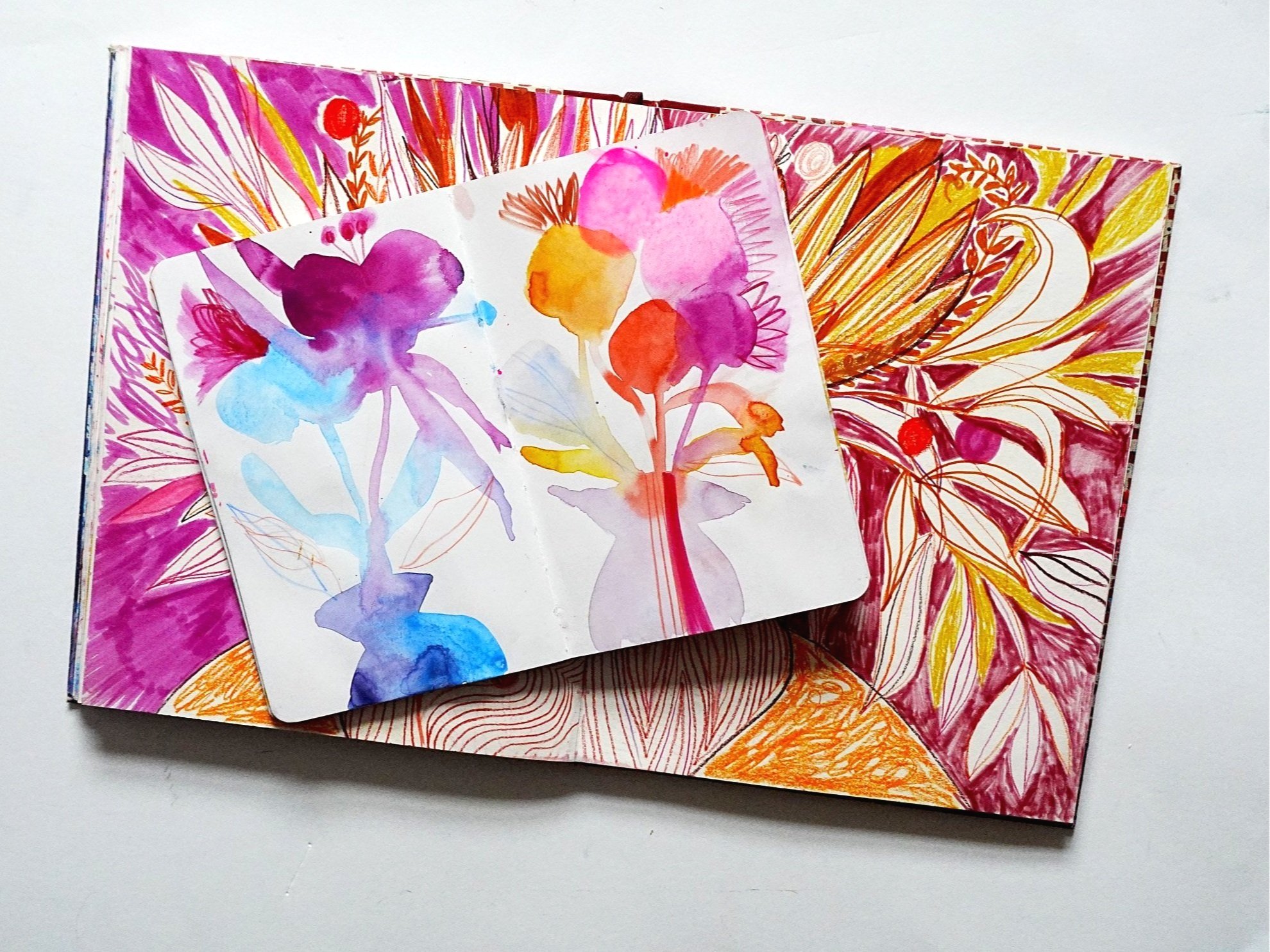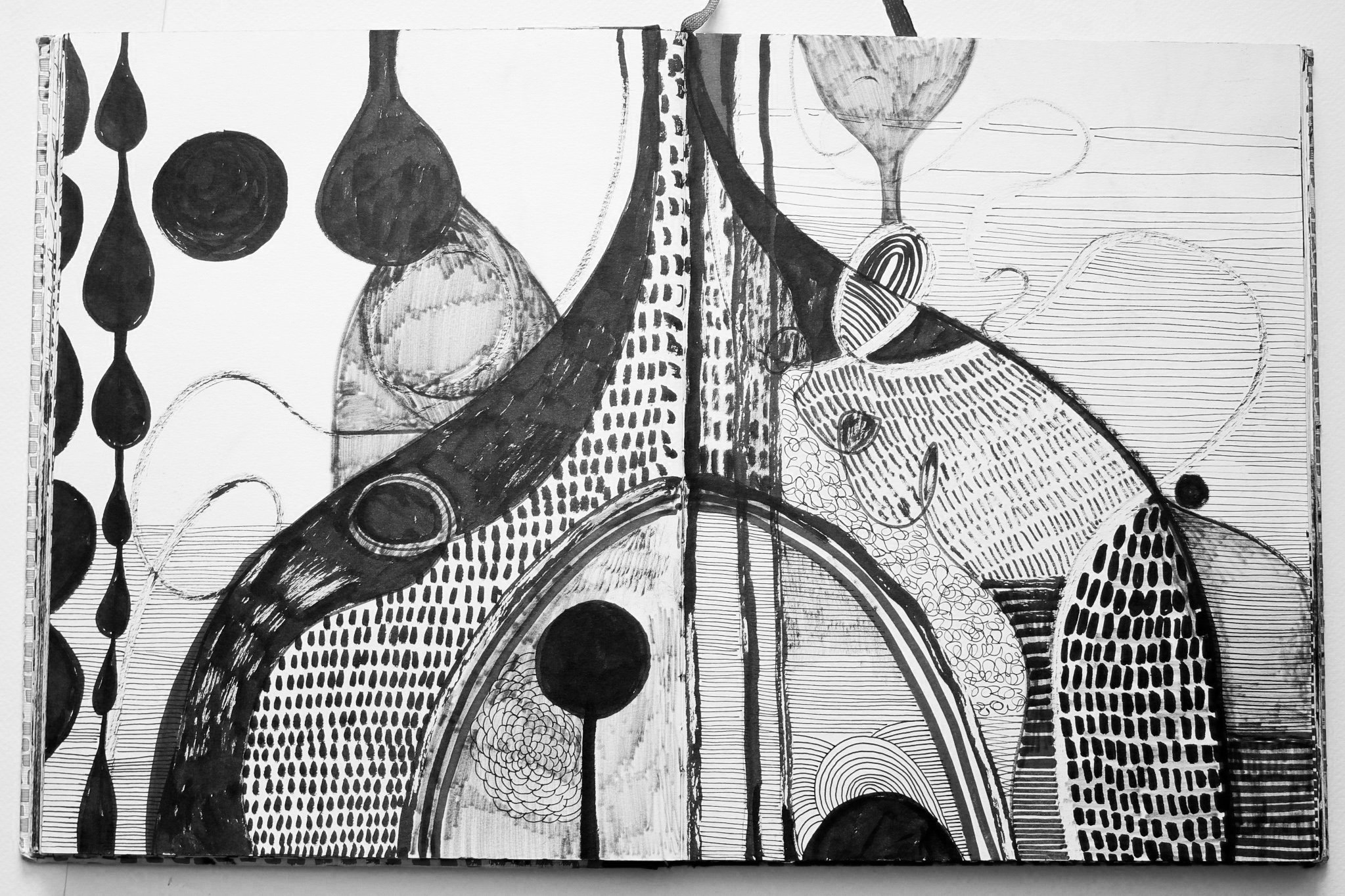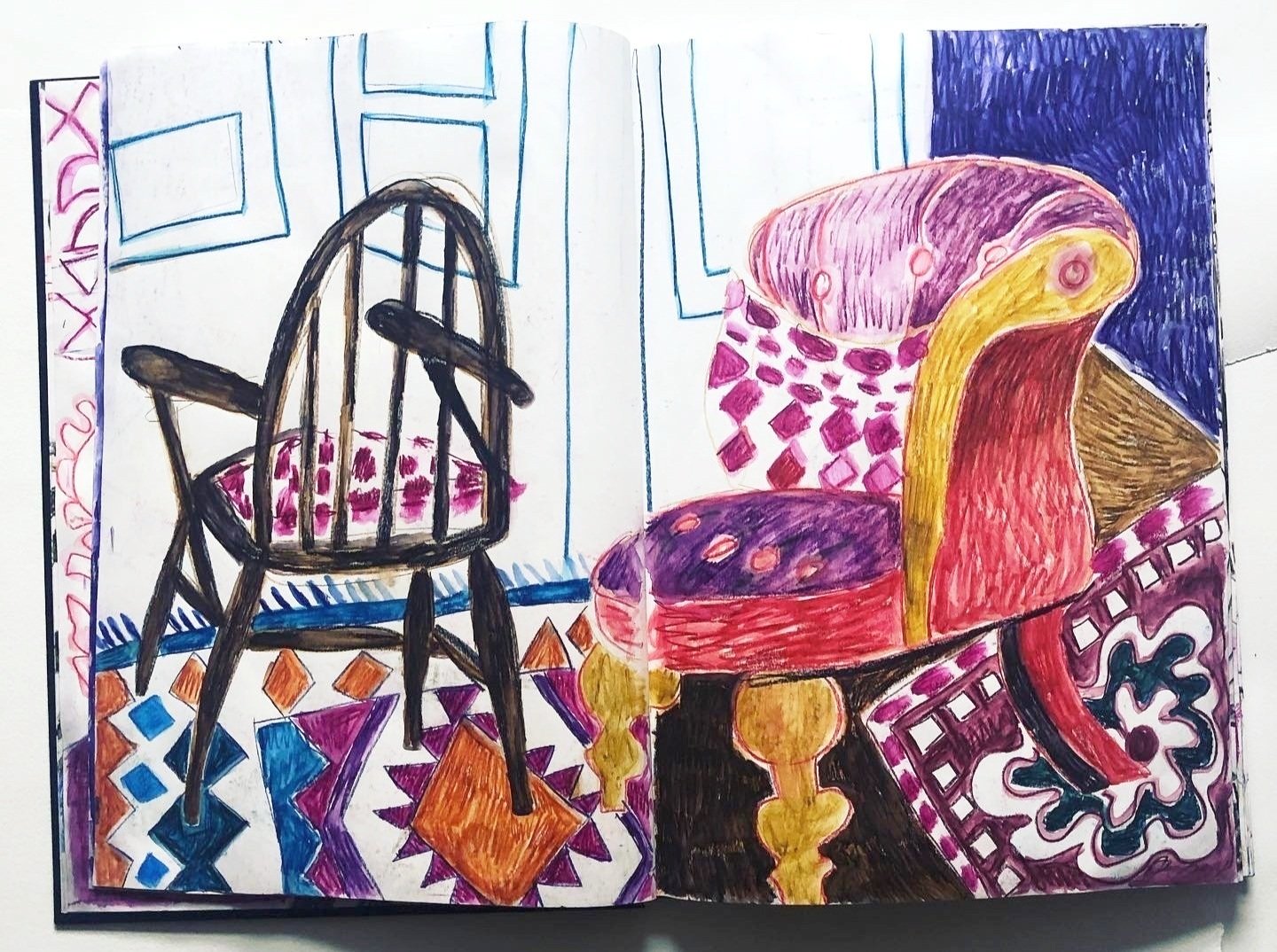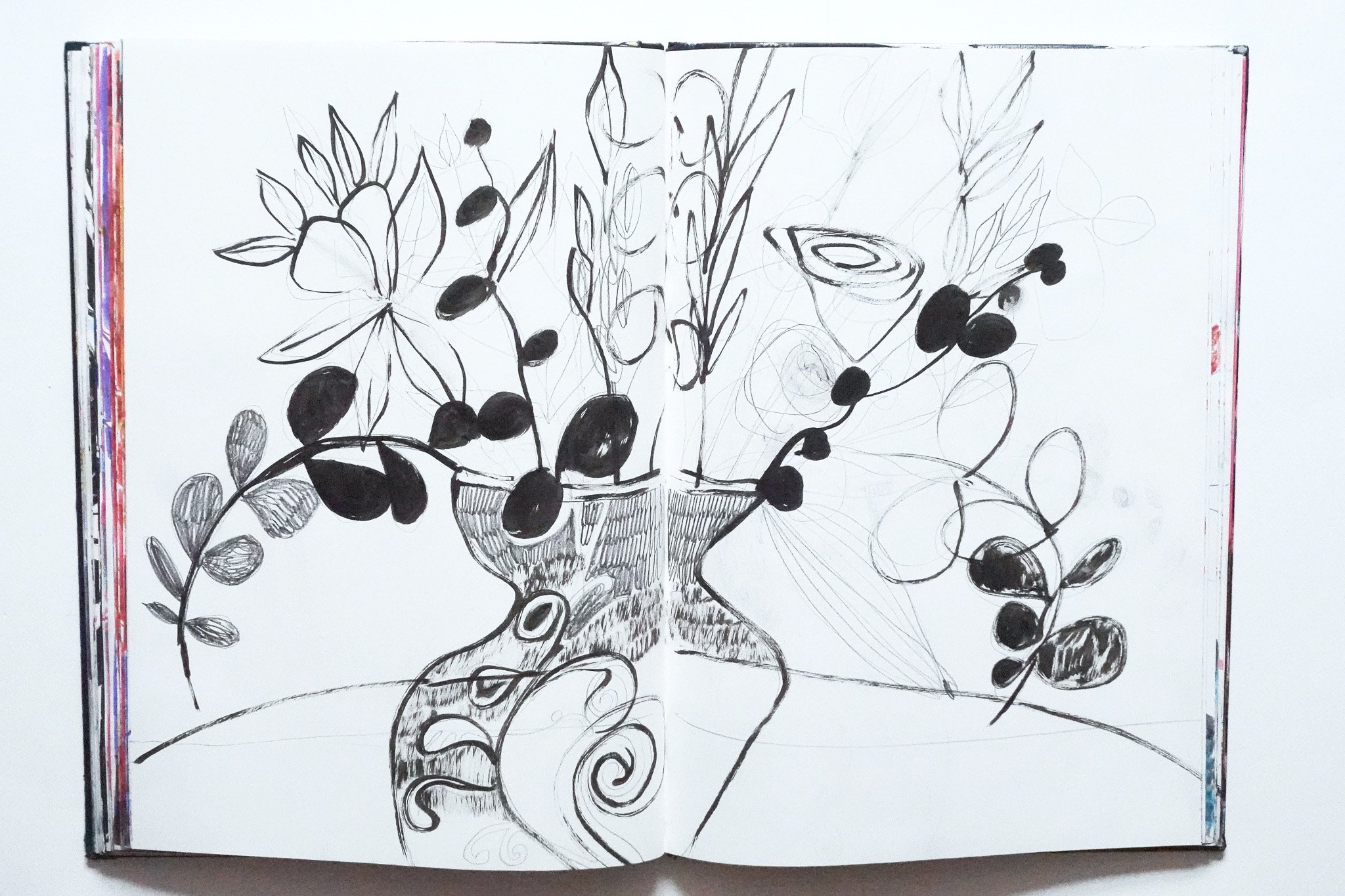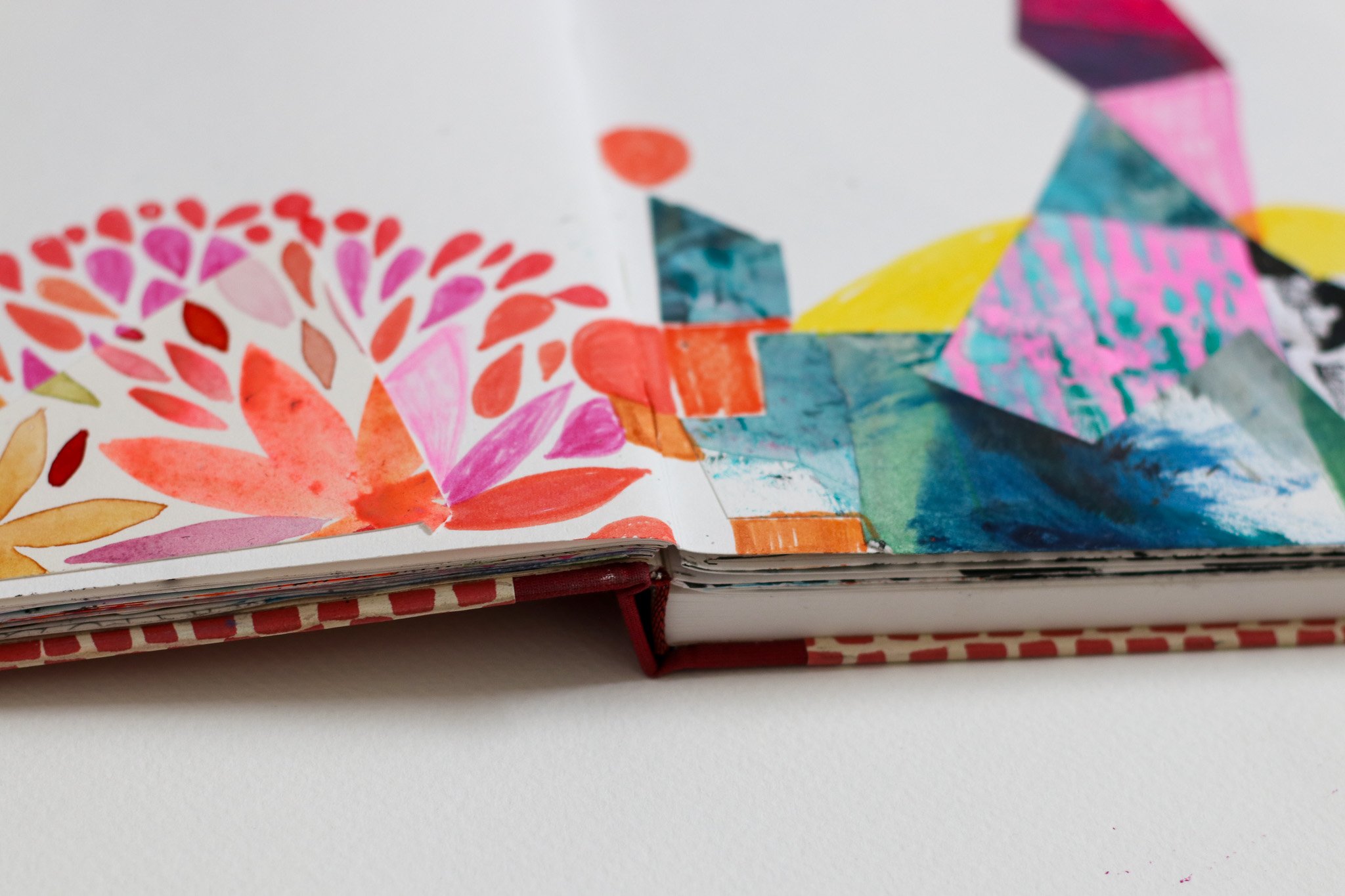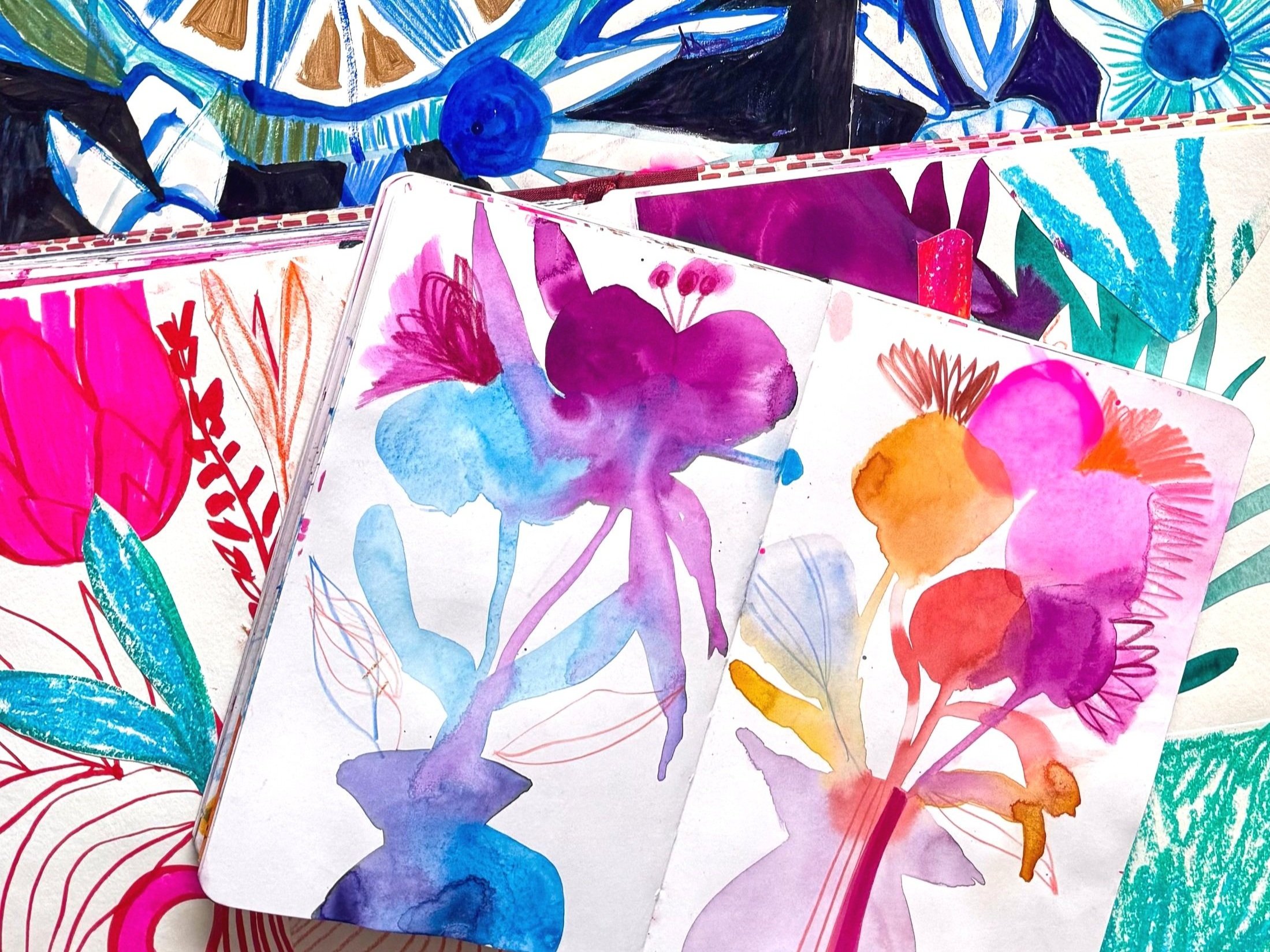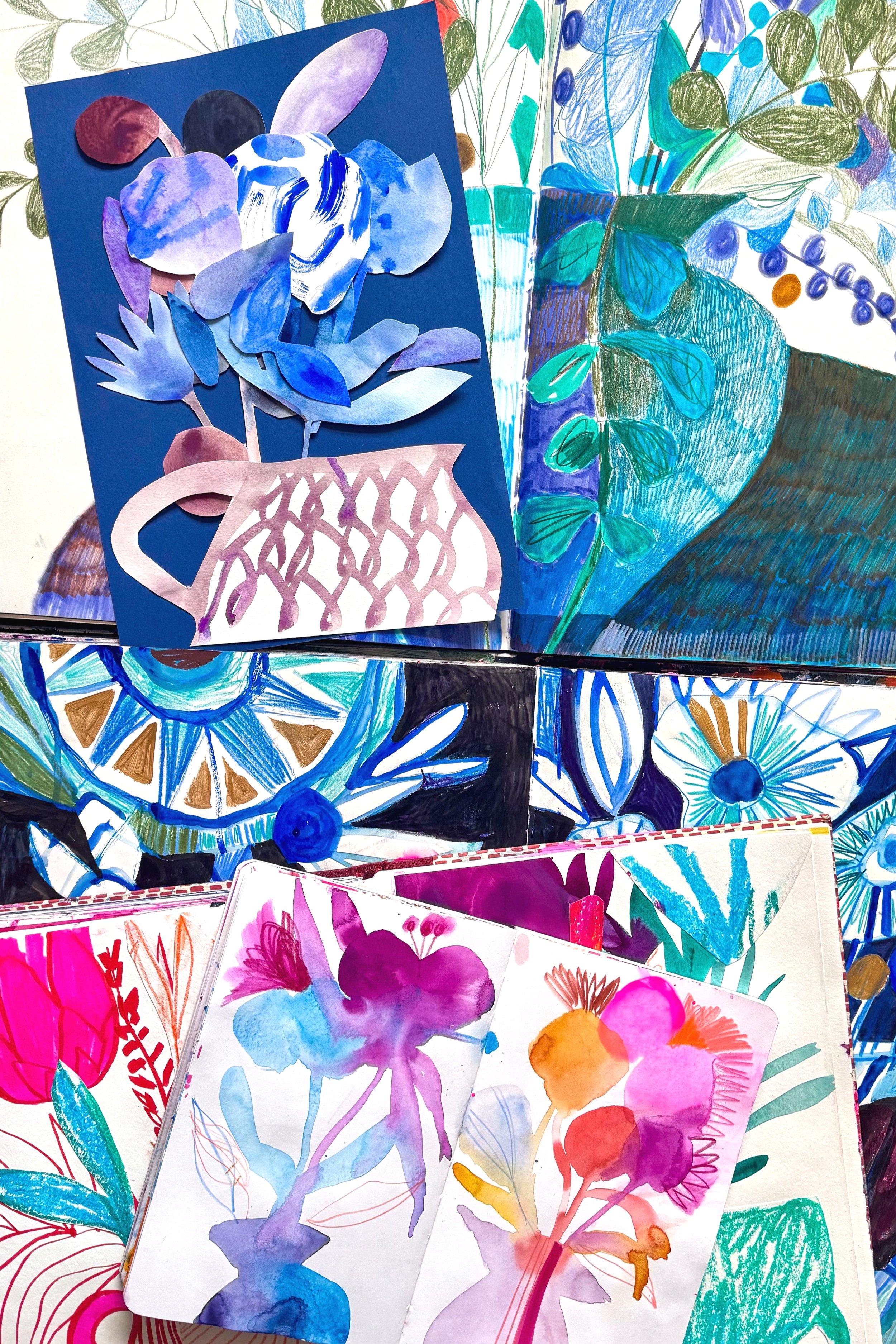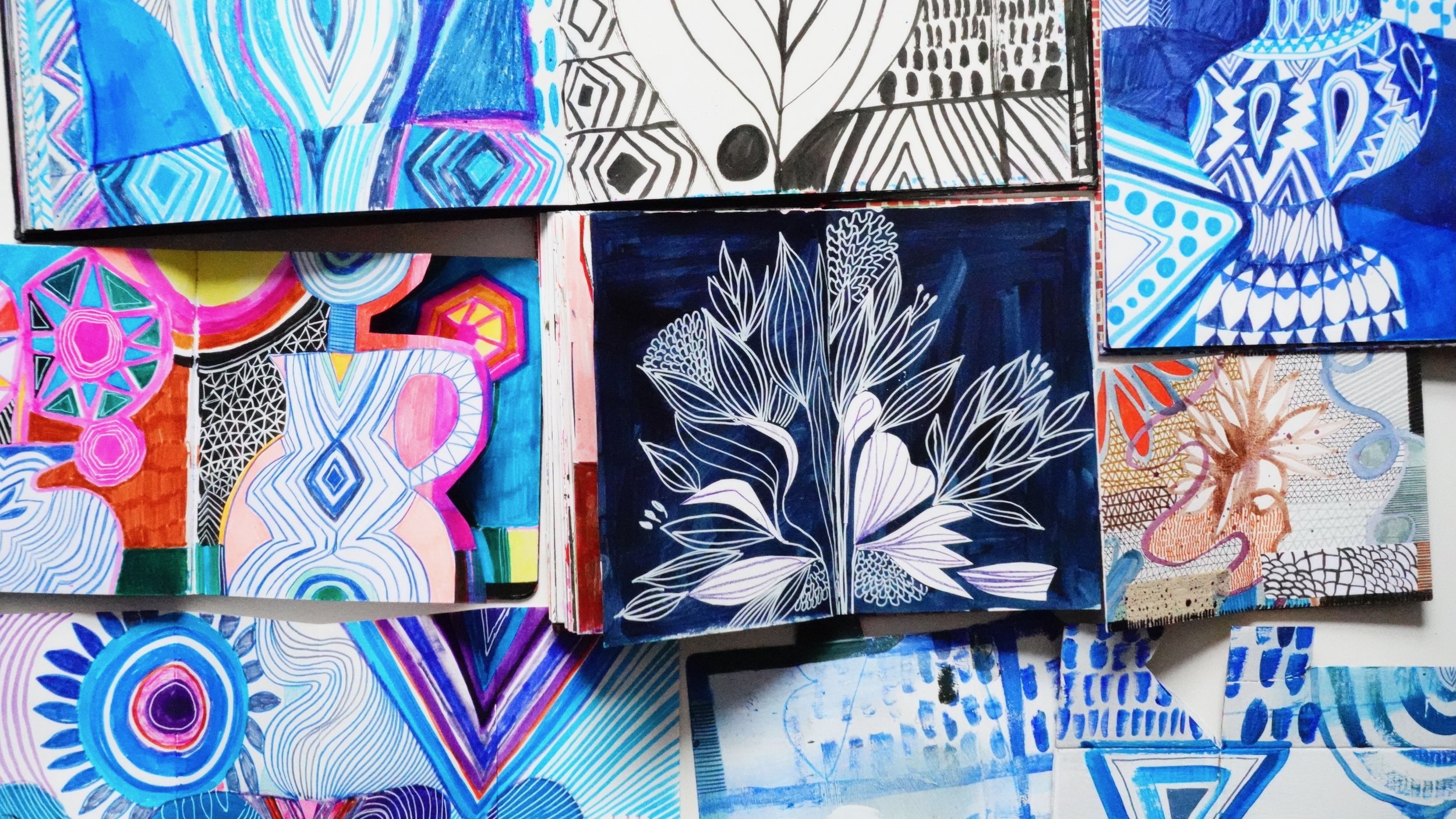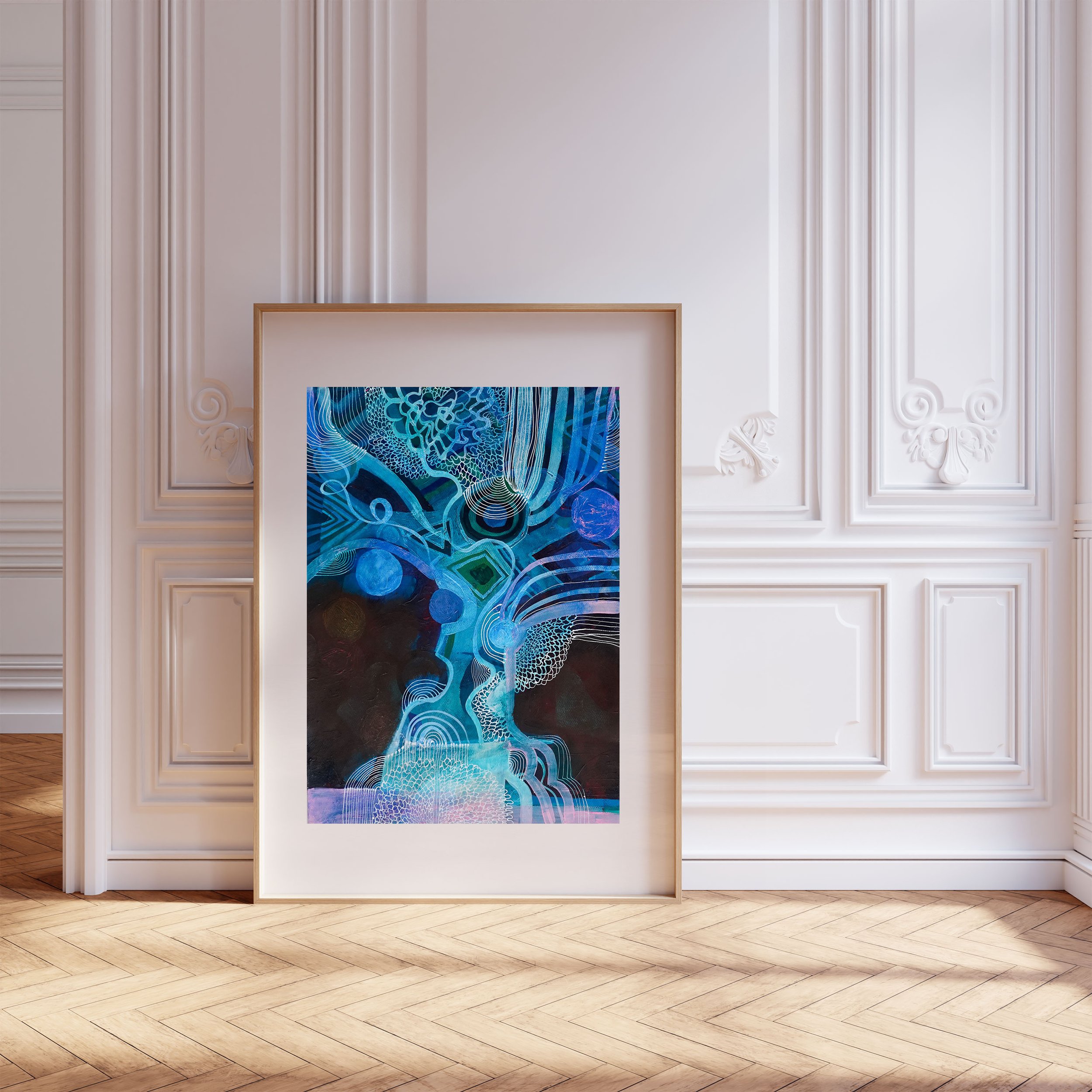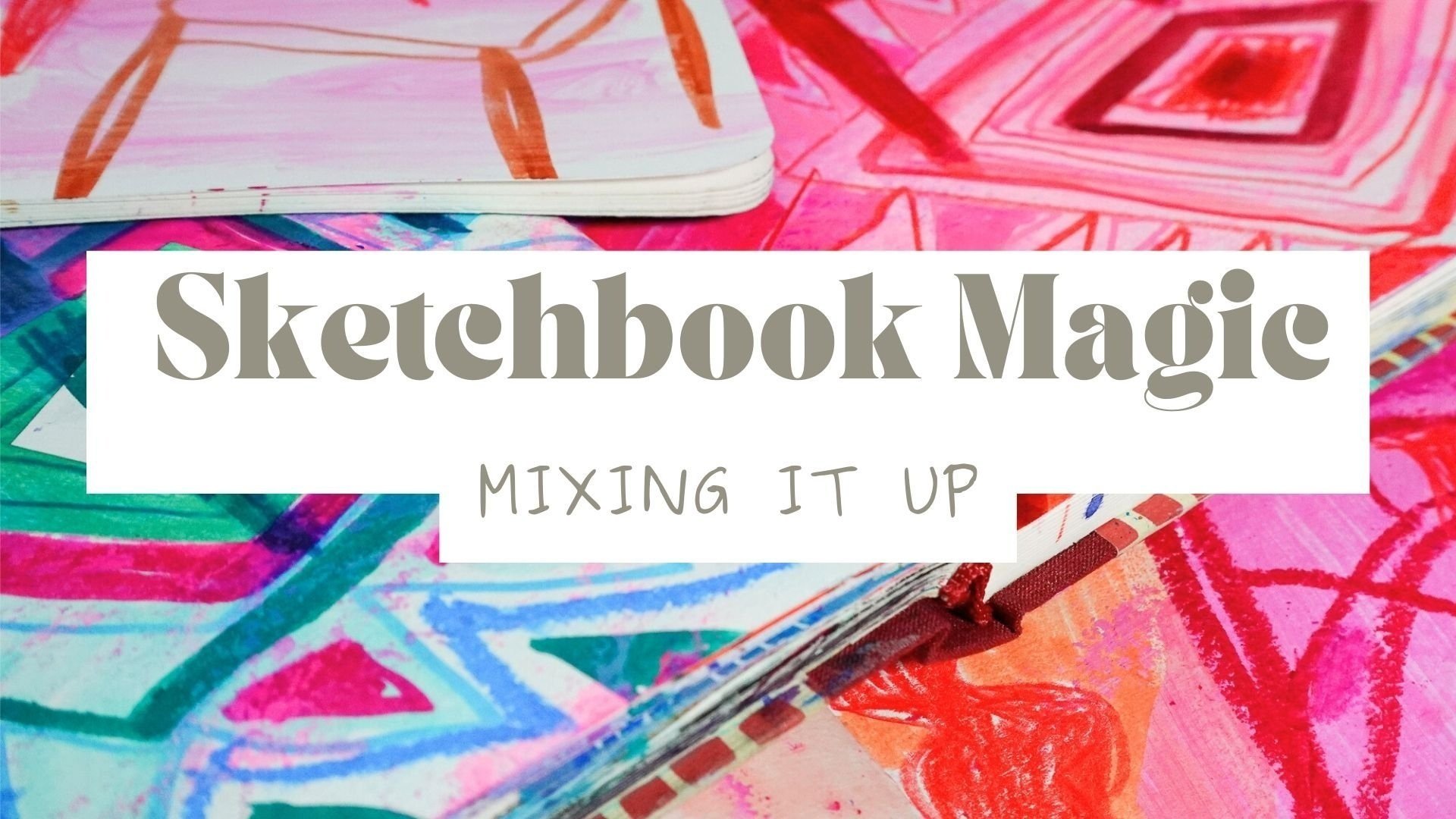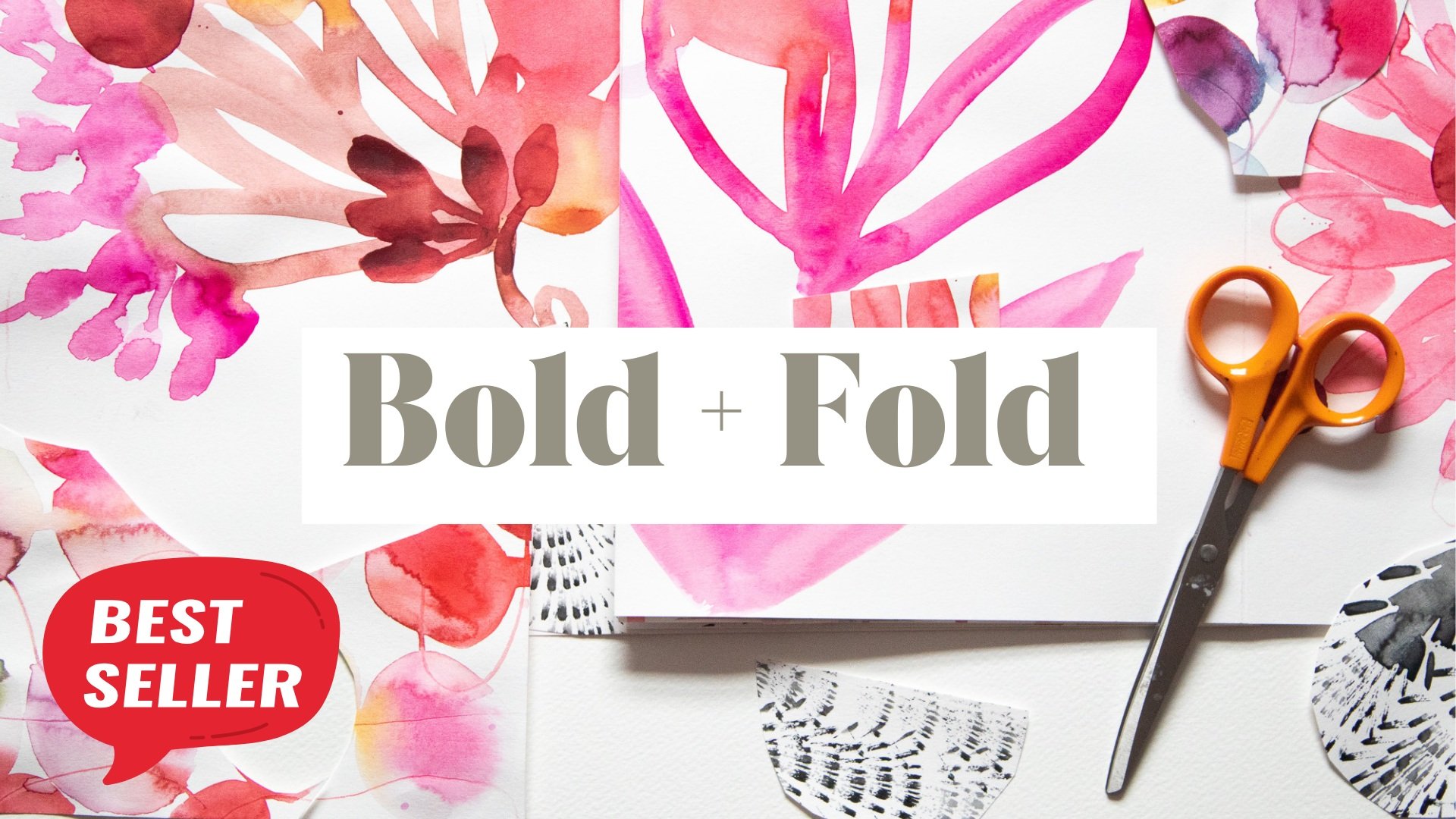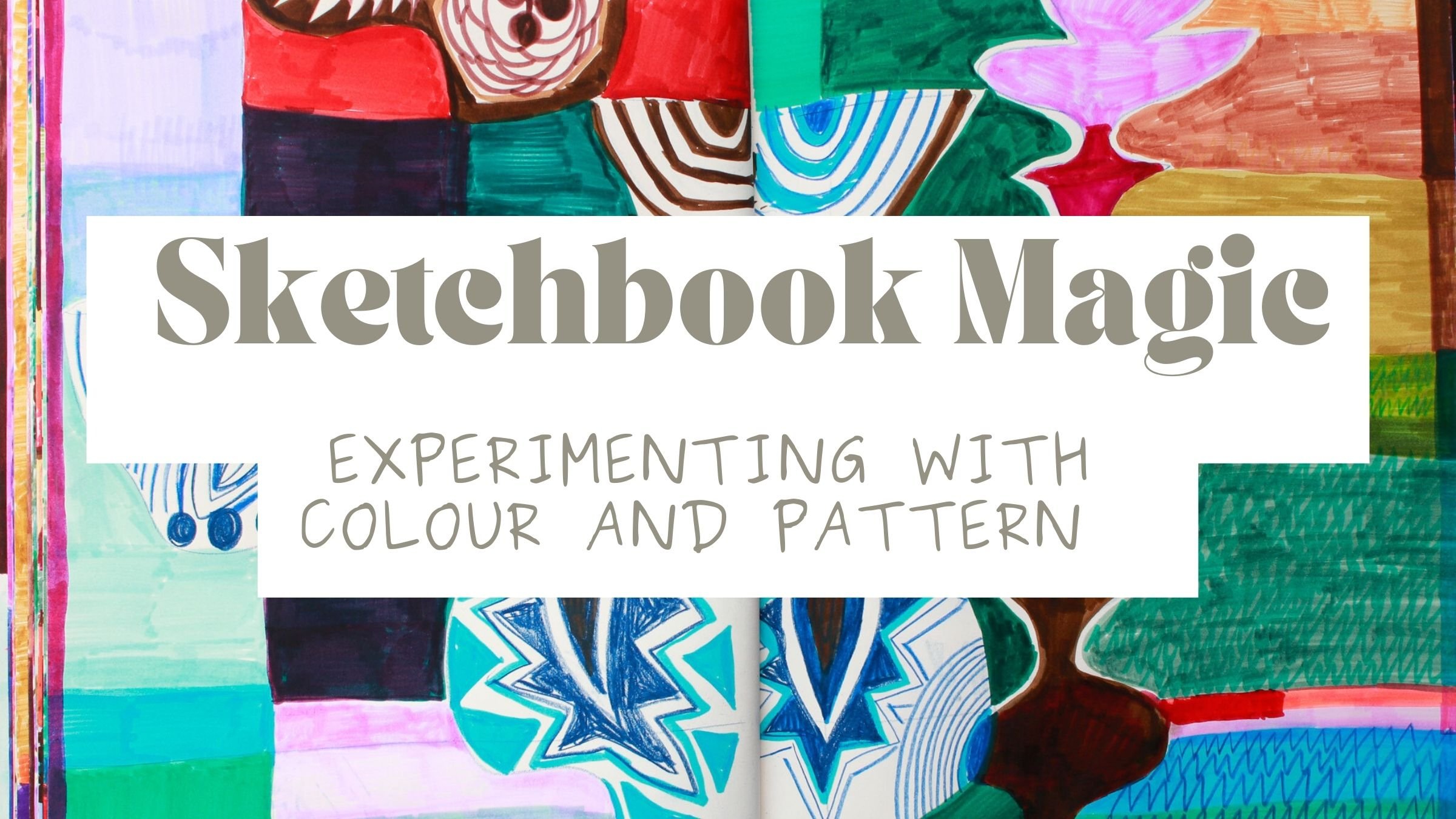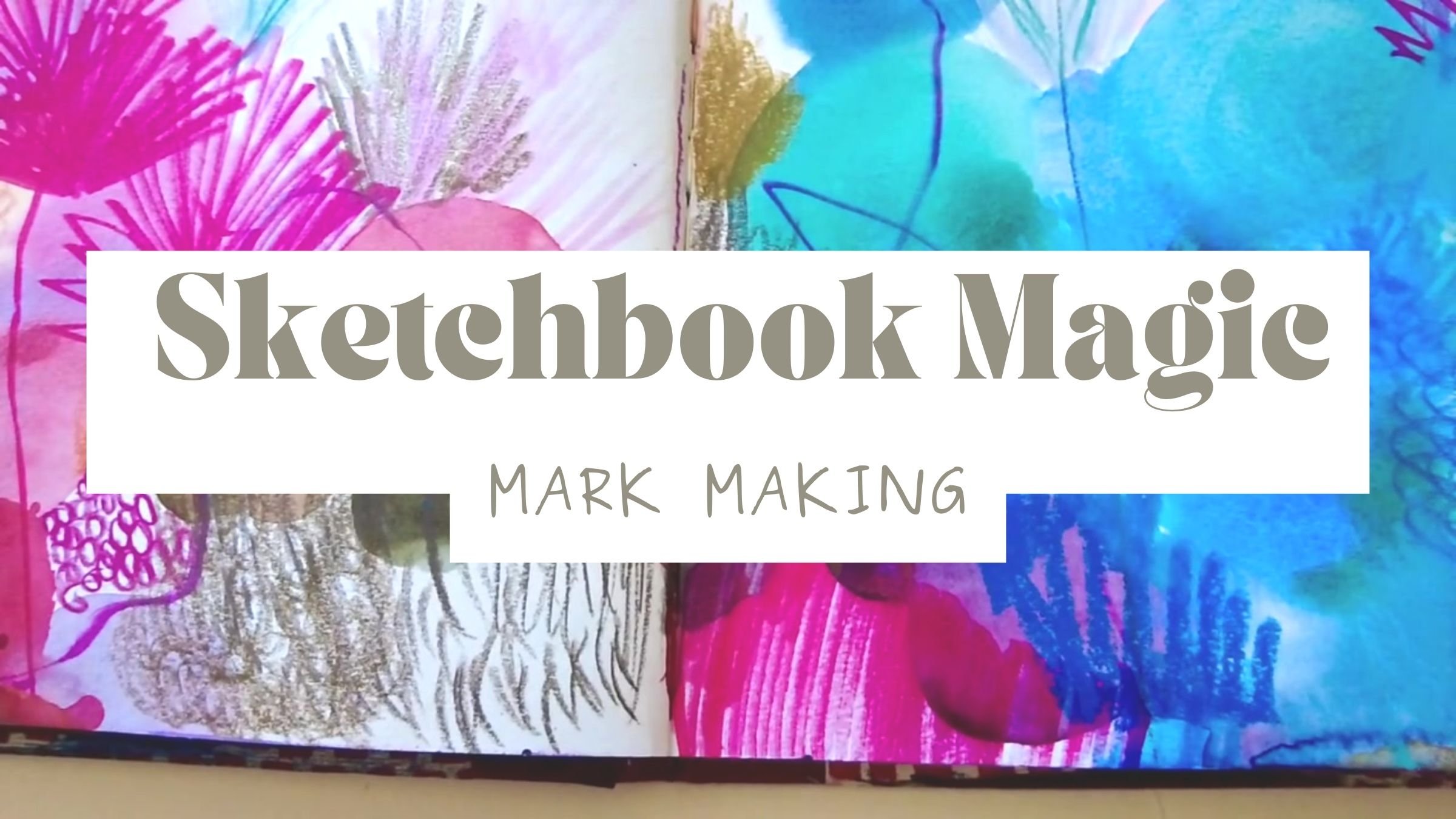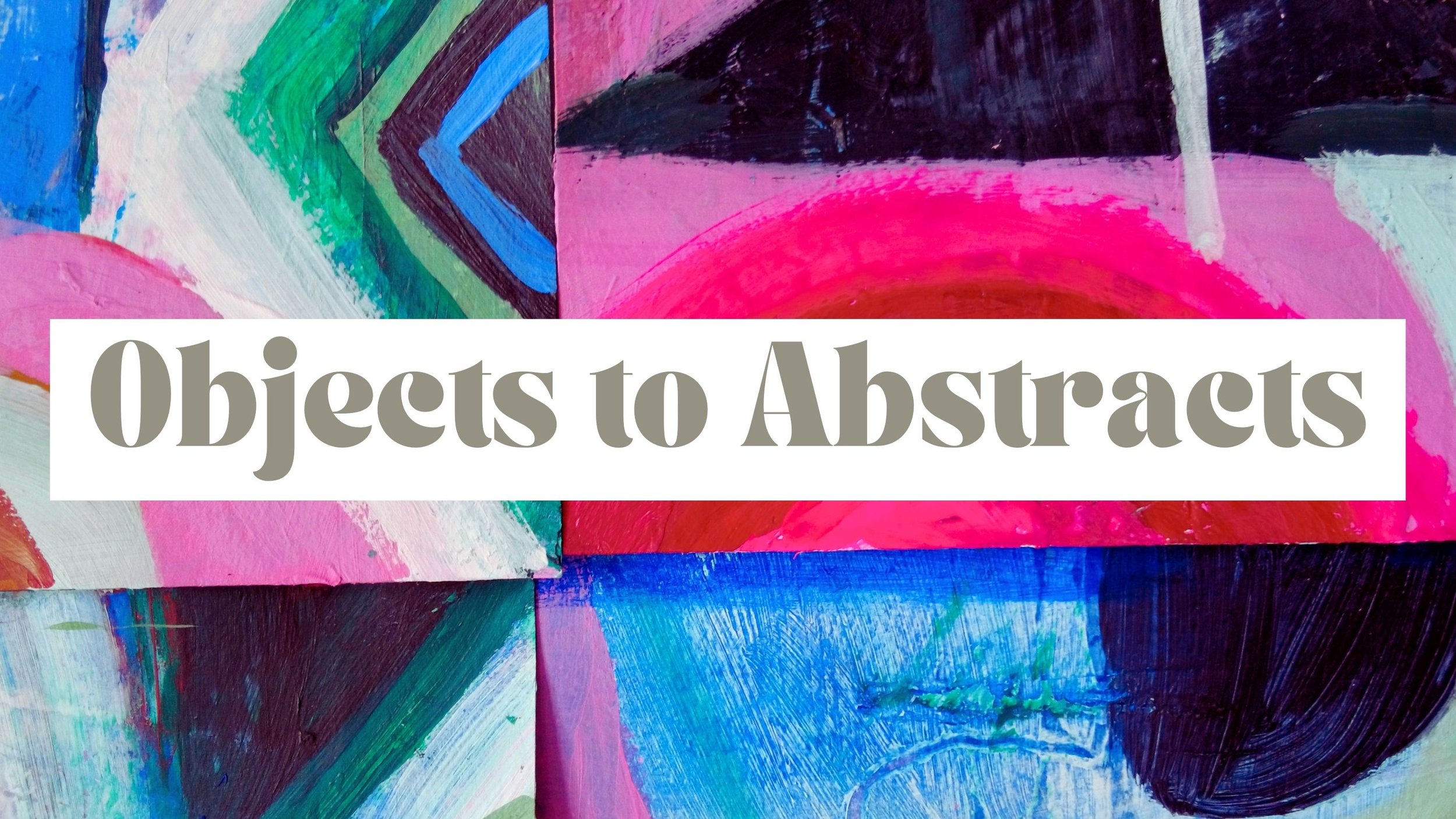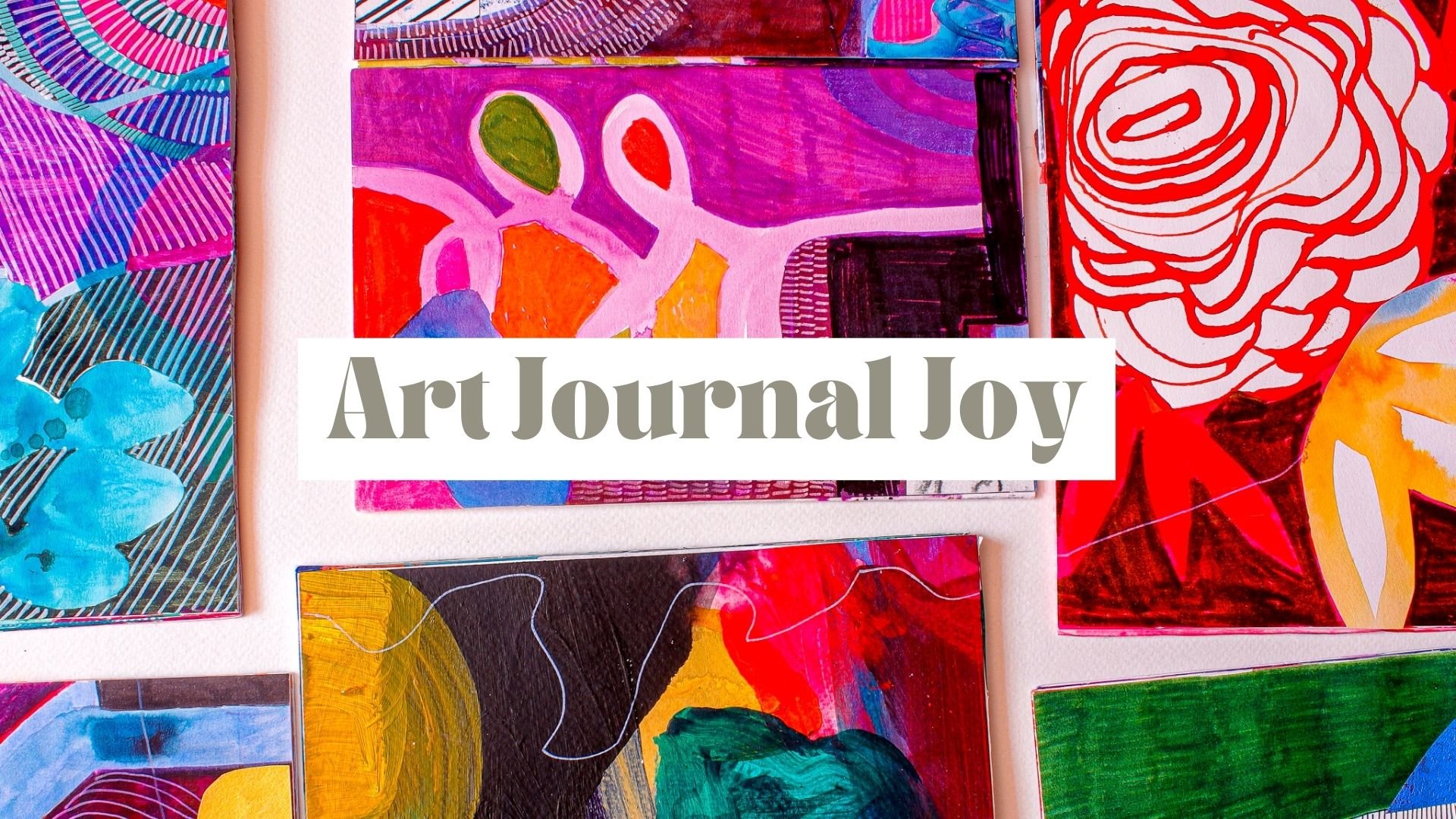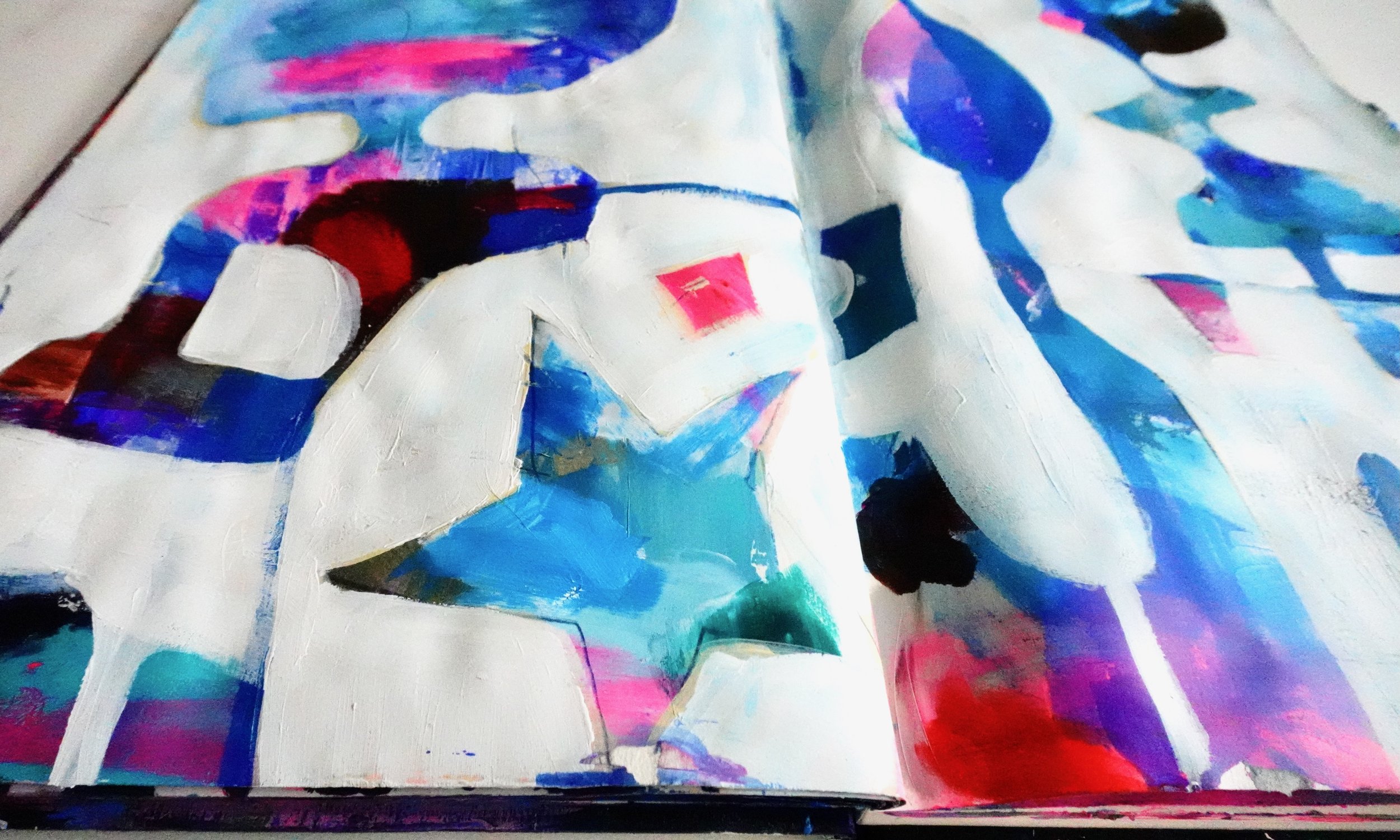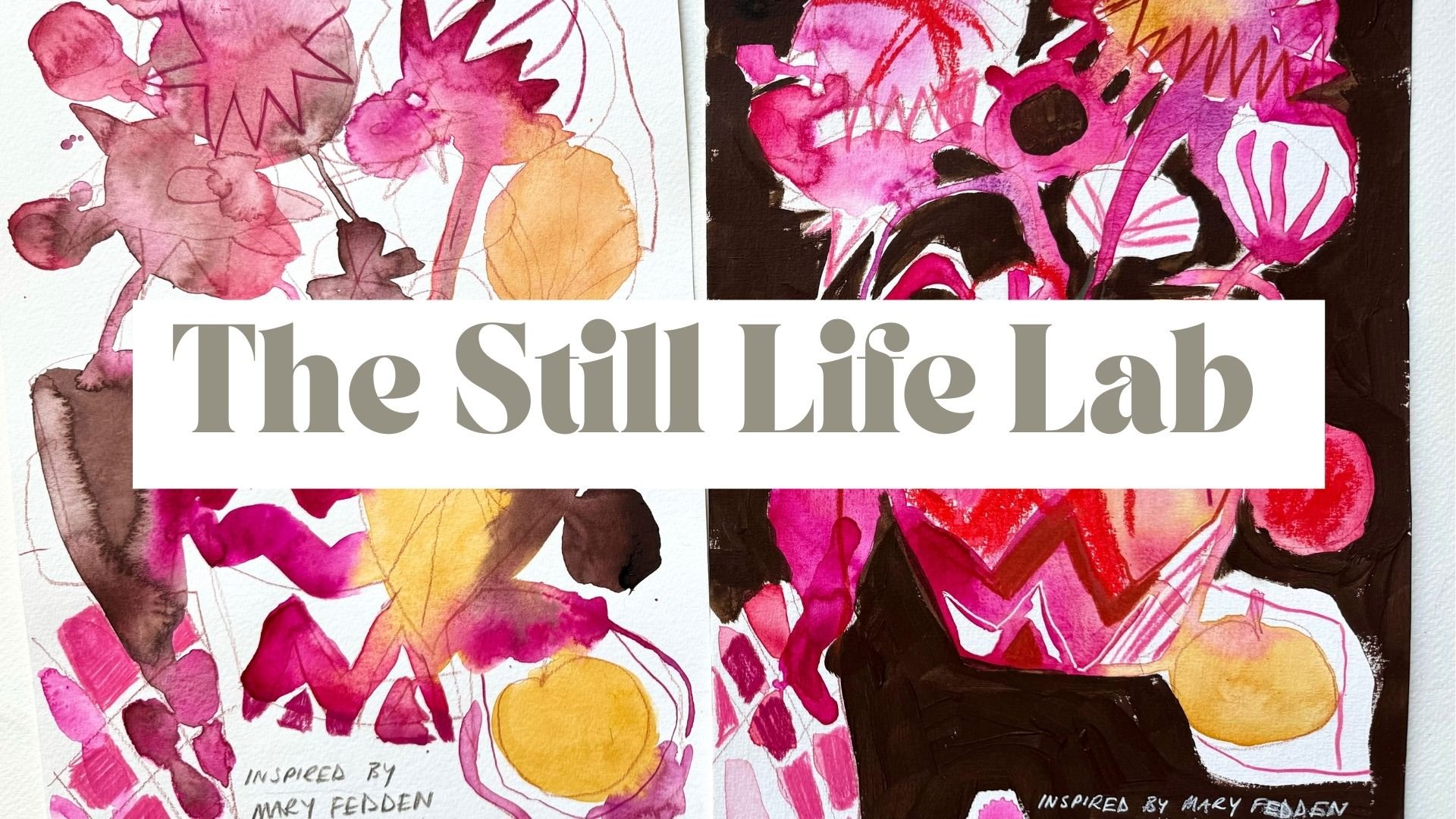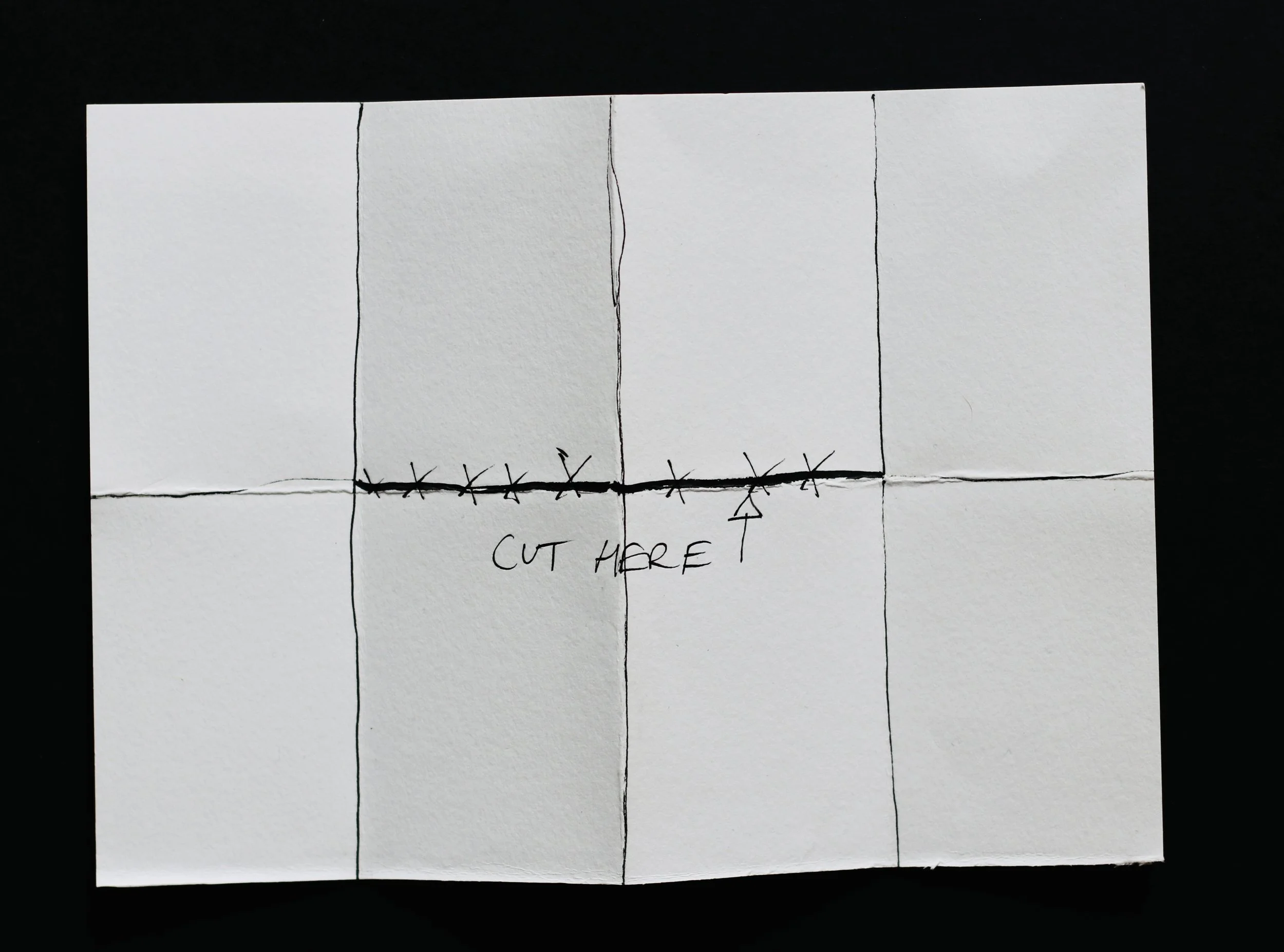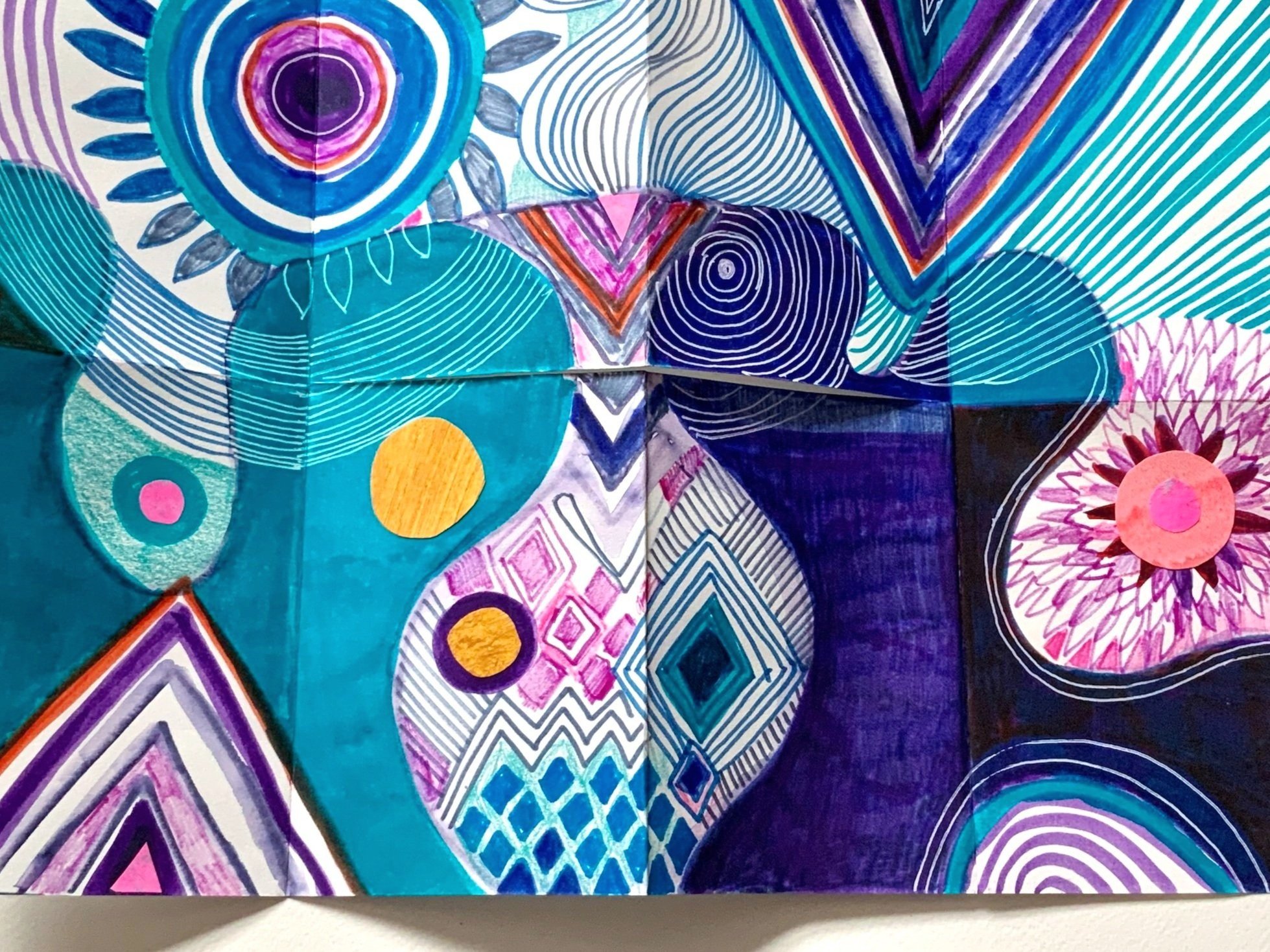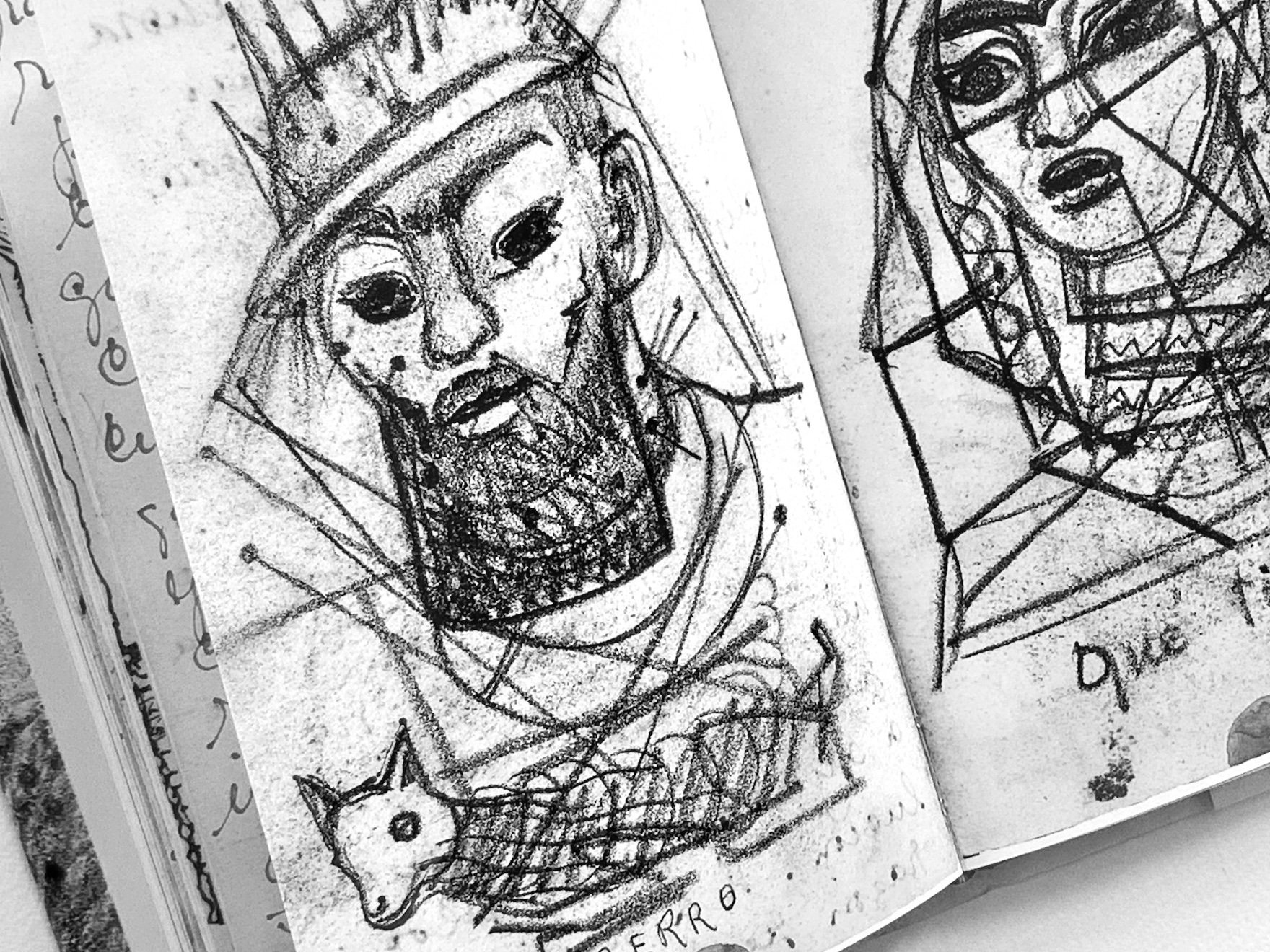
Art making ideasi
Ideas. Inspiration. A little creative mischief.
If you’re drawn to abstract and semi-abstract art, sketchbooks, colour and a little creative mischief, this is your corner of the internet.
In my blog you’ll find stories, videos, inspiration, and gentle nudges to help you create art that feels like you.
Joy as a compass…
Thoughts on finding a style and leaning in to what you love…
I used to think I had to “find my style.” Pick a lane. Pick a niche. Pick a version of myself that made sense on the internet.
But the more I tried to choose...the less like me it all felt. So I stopped chasing a style. And I started following joy.
The delight of a scribbled mark.
Colour combinations that made my heart sing.
The lines that happen when you’re not overthinking, when you’re not trying too hard. And after years of this, I can tell you: You don’t have to find your style. If you follow what feels good, it’ll find you.
You don’t have to find your style. If you follow what feels good, it’ll find you.
Because joy isn’t just a feeling or a byproduct of art making. It’s the compass. The method. The map that leads you home within your own your art.
Paying attention to all the things you love in your own art is the best way I know to make art that feels good and that embodies your style…
P.S. Joy Filled Flowers is a self-paced sketchbook class that helps you loosen up, experiment with mixed media, and bring joy back into your creative process and sketchbook practice. Online. On-demand. £58
Layering ideas
Thoughts on developing new ideas, sketchbooks and handmade sketchbooks made of old papers…
There’s something magical about flipping back through old sketchbooks. The pages are a container for our past ideas, experiments, and creative selves, some ideas are fully realised, others are only partially explored and developed.
What if these pages contained the sign posts to something entirely new?
Small sketchbooks made from scraps and abandoned pages
One of my favourite creative exercises is revisiting old sketchbooks and creations and weaving together different ideas, techniques, and themes to create something new. Layering together ideas as a way of honouring past explorations while pushing into new territory.
If you’re feeling stuck, uninspired, or just curious to see where your work can go, you may like to try this for yourself.
Gather and reflect
Start by pulling out a few of your older sketchbooks or art works, especially the ones you haven’t looked at in a while. Consider your work without judgment. Instead of critiquing, observe with curiosity. What stands out? Are there patterns, motifs, or color combinations that still excite you? Maybe there’s an old idea or composition that didn’t quite work at the time but feels full of potential now.
Hunting for clues
Look for ideas to pick and mix, mix and match. Are there any sketches, techniques, or themes that you could combine together that perhaps you wouldn’t normally put together. Maybe you have a page of delicate floral studies and another filled with bold, abstract mark-making. What happens if you created something new which combines these two ideas? Or perhaps there’s a color palette from one thing that could breathe new life into a completely different subject.
Try making a list of interesting pairings, that you gather from your own creations:
Watercolor washes + intricate pen line-work
Geometric collage shapes + loose gestural painting
Drawn details over bold botanical shapes
A sketch from years ago + a technique you’ve recently mastered
Pick and mix experiments
Now it’s time to play. Create a new piece or sketchbook page inspired by what you have found. Let go of expectations and approach it as an experiment. Maybe it turns into a finished piece, or maybe it’s just a stepping stone toward something else, but either way, it moves you forward.
Here are some more suggestions of ways to mix things up:
Redraw an old sketch using a completely different medium
Redraw an old sketch using a completely different set of colours
Take a tiny detail from an old sketch and scale it up into a full composition.
Concept stack. Take three completely different ideas from different sketchbook pages, or previous creations and combine them into something new.
Let it evolve
Creativity thrives on curiosity, so don’t be afraid to push the boundaries a little. What happens if you introduce an unexpected element? What if you challenge yourself to work in a size or format you’ve never tried before? Sometimes, the most exciting breakthroughs happen when we step up to and outside of, our comfort zones.
The beauty of looking back
Revisiting old work isn’t about repeating the past necessarily, it’s about mining it for lost treasure and using it as a bridge to something new.
Every sketchbook holds layers of who we were as artists at different points in time, and when we mix those layers together, we often uncover something surprising.
So, the next time you feel stuck, flip through your own work with fresh eyes. The inspiration you need might already be waiting for you in what you have already created.
Our previous work can give us a sign post to our future creations…
A love letter to sketchbooks
A love letter to sketchbooks…
There’s no one right way to do anything, and that includes keeping a sketchbook.
My sketchbooks feel like a motley gang of unruly but beloved friends, each one different, with its own quirks and oddities. And that’s exactly why I love them, not in spite of their weirdness, but because of it.
You know that saying about friends: “They come into your life for a season, a reason, or a lifetime”?
I think it applies to art-making and sketchbooks too. I look back at certain sketchbooks and remember those seasons of life so vividly, times when a sketchbook was an escape from life’s upheaval, a place of quiet creativity or times when it was simply a place of carefree art adventure.
Sketchbooks: A powerful creative tool
A sketchbook can be one of the most powerful creative tools an artist possesses.
For me, they’ve been life-changing. They’ve helped me move from hesitation to confidence, from creative uncertainty to finding my artistic voice. My sketchbooks have been a springboard into a more colorful and creative life. If you’ve ever considered keeping a sketchbook, here are a few reasons why you may like to start or re-start.
Making art for yourself
There is something deeply nourishing about making art just for yourself. Experimenting in a sketchbook can lift the spirits and bring immense joy. The simple act of transforming a blank page into something alive with meaning, color, and line is rewarding in itself. A sketchbook is a private place where we can have a creative conversation with ourselves. For me, it has been where I have learnt to be less critical and judgemental of myself and my art.
So many pages, so many opportunities, so much possibility has helped me loosen my attachment to how any one thing turns out…it just doesn’t matter.
A place to begin
Sketchbooks are where we find out about our own art sensibilities, not where we show up fully formed. They are part of the journey, not the final destination.
When we start working in a sketchbook, it helps to embrace a beginner’s mindset—to stay open, curious, and willing to explore. It’s okay to make mistakes, things that haven’t worked teach us something. We don’t need to expect too much from ourselves. I love this idea from Vincent Van Gogh:
“I am always doing what I can’t do yet, in order to learn how to do it.”
A place to learn and grow
In a world obsessed with outcomes, a sketchbook offers a space for discovery. It allows us to explore our interests, experiment with techniques, develop and flex the ways in which we make art. A sketchbook is where we learn what excites us creatively, where we test ideas, push our boundaries, refine our process, and reflect on our evolving art practice.
A place to practice
It is called an art practice for a reason, a sketchbook is a great place to practice and track the progression of an idea, skill or approach.
A filing cabinet of ideas
A sketchbook is more than just a collection of drawings—it’s a filing cabinet for your creativity. It gathers fragments of inspiration, allowing us to flip through pages and spot recurring patterns, themes, and ideas. Over time, our sketchbooks reveal what captivates us, helping us refine our artistic identity.
Begin where you are
A sketchbook is a companion, a teacher, a playground.
It doesn’t demand perfection. It invites exploration. It reminds us that creativity is not about flawless execution but about showing up, trying and growing.
So, if you’ve ever hesitated to start a sketchbook, let this be your sign: Begin.
Fill the pages with your ideas, your experiments, your mistakes, and your joy. Let it be a space where your creativity can run wild, unfurl and be unjudged.
You never know where it might take you.
Types of sketchbook
Here are some of the sketchbooks I like, but sketchbooks are a personal preference and come in so many different shapes, sizes and varieties, the sketchbook that is right for me, may not be right for you.
The best sketchbook to use is always the one you already own.
The Venezia Book from Fabriano
Stillman & Birn, Zeta Range
Talens Art Creation Sketchbooks
(Some of these links are affiliate links, if you buy something through them, I might earn a small commission, at no extra cost to you. I only ever share the products that I actually use. )
A sketchbook of fragments
Paintings, sketchbook ideas and art books…
This video for was filmed in December 2023
In this video I show you the progression of some abstract paintings, I take you inside a couple of my sketchbooks and share a specific approach I sometimes use to start and fill a sketchbook….I also share a few books I’m currently inspired by.
If you ever find yourself with an assortment of paper scraps, abandoned sketches, old art excercies or leftover bits from other projects you may like to try this. Instead of letting them pile up or throwing them away, turn them into a creative and joyful sketchbook practice.
I call this my Sketchbook of Lost and Lonely Fragments, it’s a low-pressure, intuitive way to explore composition, color, and mark-making.
Getting started
Collect scraps of paper, painted off-cuts, patterns, abandoned doodles, or any interesting textures and colors that speak to you. These could be anything from torn magazine pages to leftover swatches of paint on a palette.
Randomly glue them in to your sketchbook. Try not to overthink this bit, start adhering these fragments across the pages of your sketchbook.
Use the whole sketchbook. Work through your entire book, placing snippets on each page. This disrupts the intimidating blank page and provides a playful starting point for future creativity.
Developing the pages
Once your base of fragments is in place, you can revisit the pages at random and begin developing them further:
Explore intuitive mark-making. Use pens, pencils, markers, or paint to add details. Try drawing lines, shapes, patterns, or shading to interact with the fragments.
Experiment with composition. Let the placement of your scraps guide your creative choices. Try and create a balanced page by emphasising certain areas, using colors and exploring contrasts.
Play with different materials. Collage, stitch, paint, or even cut through pages to create unexpected layers.
Let surprises happen. Approach the process without a fixed outcome in mind. The goal is to stay playful and see what emerges naturally.
Why you many like to try this approach
It reduces the pressure of perfect. By starting with an already ‘disrupted’ page, you bypass the fear of the blank page.
It encourages playfulness. The randomness of the fragments leads to spontaneous and surprising compositions.
It fosters creative exploration. Working in this way encourages new ideas, unexpected juxtapositions, and unusual combinations.
Turns scraps into treasure. Re-use your abandoned art experiments. What was perhaps discarded now becomes an integral part of a creative process.
I think creating in this way is an invitation to embrace imperfection and spontaneity. It’s a reminder that art doesn’t need to be pre-planned or polished—sometimes, the most exciting discoveries come from embracing the unknown and unexpected.
So consider this a small invitation to gather your scraps, open your sketchbook, and start creating.
Books and links
Mark Hearld Workbook published by Merrell 2012, words by Simon Martin. You can follow Mark on instagram
Picasso on Paper, a catalogue from the The Royal Academy of Arts 2020, to accompany the exhibition of the same name. There is a Youtube video of the exhibition here
Brian Wildsmith, 123 first published in 1965, by Brooklyn Art Books for Children. There is a website cataloguing Brian’s books, art and illustration here or there is an instagram account managed by his family
The two sketchbooks I show is this video are 1. The Venezia Book from Fabriano and 2. A3 Ebony Artist Sketchbook from Daler Rowney.
Balancing chaos and focus in art making
Here I share some thoughts on how creativity works…
Creativity often swings between inspiration gathering and disciplined execution. At the start of any creative endeavor, we might need a little chaos—openness, curiosity, and exploration. But to bring an idea to life, we need the opposite: clarity, focus, and determination.
Sometimes, we need the scattergun. Sometimes, we need the laser.
As I write this, I’m in the thick of filming my next online course. The process of creating this course has made me reflect on how creativity often demands two distinct modes: exploration and execution.
For the past two months, I’ve been in the scattergun phase—of coming up with ideas, hunting, gathering, experimenting, and throwing ideas at the wall to see what sticks. I’ve been absorbing books, discovering new artists, writing notes, journalling, sketching, expanding different techniques, and letting curiosity lead the way. This stage thrives on novelty, variety, and stimulation. It’s a time for playful chaos—inviting in fresh ideas, mixing influences, and allowing creative sparks to ignite.
But now, I’m in the laser phase—actually turning the ideas into a reality. Taking all the threads and creating the thing. This requires a completely different mindset: deep focus, structure, and an ‘all-in’ mentality. The distractions that once sparked ideas now threaten progress. Instead of jumping between concepts and tasks, I must commit, push through challenges, and sustain intense concentration.
This dance between divergence and convergence happens in most creative endeavors. It happens when making art—we start with an open field of possibilities, then gradually we define a path, make firm decisions, and commit.
Navigating the two modes in art making:
Embrace the scattergun phase fully
At the start of a project or new body of work, embrace the ambiguity and uncertainty. There is often a lot of ‘not knowing’.
Experiment with different materials, colours, techniques, styles and subjects—invite in the ‘new’ or novel without pressure or expectation.
Seek inspiration from unexpected sources: museums, obscure books, nature, seek outside of your usual circles of reference...
Fill sketchbooks with unfiltered ideas—sketchbooks are often divergent thinking in action…lots of experimentation, gathering, connecting dots…
Follow your intuition. Let curiosity guide you. Resist the urge to make sense of everything immediately—connections and breakthroughs often emerge over time.
Give yourself the opportunity to rest and the space to think if you can; creative ideas often surface when the mind is relaxed. “I’ll sleep on it”…is a truism for a reason. Allowing a little spaciousness into our lives, is fertile, it can allow ideas to take shape and grow.
Gather inspiration like you’re building a virtual pinboard—often, magic happens in the weird combinations and unexpected connections.
Commit to the laser phase when it’s time
Finishing an artwork or any creative project often requires a real focus and concentration. Align deep work with your natural energy cycles—concentration flows best when you work with your own rhythms.
Set aside dedicated ‘studio’ time to refine, develop, and focus on your work. Set a timer for an set period of intense concentration and deep focus
Trust the instincts you developed in the exploration phase—this stage is about shaping, not second-guessing.
Reduce distractions (social media, external input) and fully immerse yourself in the process.
“Efforts to deepen your focus will struggle if you don’t simultaneously wean your mind from a dependence on distraction.”
― Cal Newport, Deep Work
Know when to switch gears
If your work feels chaotic and unfocused, it might be time to narrow in and commit to a single direction.
If you feel stuck or uninspired, loosen up—step away, explore new references, invite in something new or experiment freely again.
Creativity in art and life isn’t about choosing one approach over the other—it’s about learning to move between wild experimentation and disciplined refinement. The scattergun fills the well; the laser brings the vision to life. It seems to me that both are essential.
Creativity can be a balm for the soul
Creativity is a balm for the soul…
“A lot of people don’t feel creative because they’re physically and emotionally exhausted. The recipe for your life should be this: rest until you feel like playing, then play until you feel like resting, and then repeat.”
2025 has unfolded slowly for me. I’ve been poorly with something resembling flu and have spent much of this new year in my pyjamas coughing …
Pencil sketchbook pages from last year
I have done little in life or art, but now I am feeling a bit stronger I have spent some low-key, quiet time meandering in my sketchbook.
Playing with some simple drawing materials… Expecting very little of myself, creating as a lovely distraction. Manufacturing small moments of joy, just as a nice thing to do. Creating for the sake of creating, not for any outcome, just for the experience of doing it.
A sketchbook from a few years ago…
It has made me think about the healing nature of creativity and how beneficial my sketchbook practice has been to me through difficult passages of life.
The last five years have presented a small rollercoaster of personal challenges, as I’m sure they have for many. I’ve had some on-going chronic health issues, my mother died after being ill for many years and we had a house flood which meant we had to re-build the bottom floors of our home whilst living in a hotel for many months… and through it all my sketchbook practice has felt like an anchor, it has been a wonderful balm for my soul and a comforting creative place to go.
Creating in my sketchbook has felt restorative, enriching and up-lifting, sometimes fun, sometimes a necessary source of calm and distraction. A small place to go and be creative. A place where I can just do a little, or sometimes a lot. Sometimes a place to rest and refuel, sometimes a place to wonder and be wild.
Previous sketchbooks
When life seems to derail our creativity, and when things happen that dampen our natural desire to create … it is perhaps in exactly these moments of life that creativity can be important.
In times of difficulty, small creative moments are perhaps more crucial, they can provide hope, light and encouragement. When we create art we are reminded of valuable lessons which are also needed for life. Our whole life is a creative act, which requires courage, problem solving, tenacity, a sense of adventure and optimism. And when we make art we remind ourselves of our ability take a blank page and make it into something meaningful.
A creative practice can be life-enriching and supportive, whatever is happening…
My sketchbook has been both a refuge and an escape. Using a sketchbook has provided a nourishing playground, a sanctuary and a safe harbour when waters have been choppy. It has been a place to ground both myself and my art.
Small handmade art journals
My sketchbook practice has been so valuable to me only because my expectations are so low.
The stakes are low. It is a place for me to create for the joy of creating, a place to create art for the sake of creating art. A place to make anything I want to make. A place where the activity is perhaps important than the outcome. Scribbling and mark making is sometimes enough.
A sketchbook is personal. Your sketchbook, your rules. It’s a place to primarily make art for yourself, to let your interests and style iterate and unfold, it’s not about displaying art, getting approval or finished and finessed works, it’s a place to work things through, figure things out and have a creative conversation with yourself. Or just to play about with materials, to colour-in, because that is what you need in that moment.
Pencil and felt tip pen sketchbook page
Whatever is happening in our lives, creativity can support us in small and large ways.
Creativity is an important way to express ourselves, connect with ourselves, understand ourselves, a way to cope, a way to find hope, a way to meditate, think, feel, process and reflect.
Ultimately making art is a way to come home to ourselves…
A pencil drawing in my sketchbook
A pencil Still Life drawing
Drawing and exploring in a sketchbook
Love of Pattern
This is a love letter to pattern. Take my patterned sketchbook tour and see some art books to inspire…
My love of decoration, ornament and pattern has been a life-long love affair.
All of my very earliest childhood memories involve pattern in some way..,the wallpaper in my infant bedroom, the pattern of a dress, a carpet, a bedspread, a plate, the decoration on our neighbour’s biscuit tin when I was only three or four. I see and remember the world via pattern.
The art we make reflects who we are back to us, doesn’t it?. It can be a projection, an extension of who we are, a culmination of our experiences, our sensibilities, our curiosities, our feelings…. And my art definitely celebrates a love of pattern.
Humans are pattern makers
I think perhaps patten also has an instinctual universal appeal too. Humans are pattern makers and pattern seekers. From the earliest times we have added ornament, decoration, motifs and marks to the items in our world, we turn the ordinary into the extraordinary through making our mark on the world. .We have always added pattern, ornamentation, decoration and detail to the items in our lives to make our lives more beautiful.
Humans are pattern seekers
We seek patterns as a way to understand the world.. there is comfort, familiarity and understanding in repetition and repeats…and at it’s most basic form that’s exactly what a pattern is. It’s a shape, a motif, a mark… repeated.
I seem to agree with the saying that ‘repetition makes perfect’…
Books and links
Here are the books I share in the video.
Terry Winters. Paintings, Drawings, Prints 1994–2004 Hardcover, 2005 by Richard Shiff (Author), Rachel Teagle (Author) Published by Yale University Press.
This book is now out of print but you can see more of Terry Winter’s art on his website here
Matisse in the Studio Hardcover – 6 April 2017 by Ellen McBreen (Author) et al, Royal Academy of the Arts
Looking back to go forward…
This blog is about reviewing our work, looking back at our art with an inquisitive and curious eye…
In this video I show you some recent studies, sketches and sketchbooks and chat about how I often review my artwork as a way to take stock and inform my next art making move….
Spending a little time looking back over previous creations is a lovely way to recall, retain and be reminded of things that may have been forgotten and can bring clarity about what to make next.
REMEMBERING AND REMINISCING
Looking back over work we have previously created is like catching up with old friends, remembering and reminiscing.
CONNECTIONS AND COMBINING
When we look at our work collected together we are better able to see connections and themes and ways in which we may like to combine elements and ideas together to create something new.
I find it useful to review my work with an inquisitive eye, asking questions such as:
What do I find interesting here?
What is calling to me?
What do I find visually pleasing? A colour, a mark, a line quality, a combination or juxtaposition?
Why does this appeal to me?
How does it feel?
How do I want my current art to feel?
How could I evolve this?
How could I develop it?
I find that what I have already created holds important signs or signals and reviewing it can ignite something new or prompt me to explore and expand on a theme or technique, spending time ‘mining’ our own creations can be a useful way to better understand our own artistic sensibilities and style.
THE PAST INFORMS THE FUTURE
There is a lovely continuum in art making, everything that we’ve made before, we bring to our new creations, nothing is ever wasted, it’s like everything we’ve already made informs everything to come….and I relish that continuity and evolution…
Need a little sketchbook inspiration?
Take the Sketchbook Love Class.
It is FREE today
How to make a simple sketchbook
Learn how to make a simple concertina book which can be turned into a more regular sketchbook with a little glue…
In this video I show you how to make a simple sketchbook from one large piece of paper. The bigger sketchbook in the video is made from an A1 sheet and the smaller one is made from an A3 sheet.
I make these simple one page sketchbooks very frequently and have for many years. There is something extremely tactile and pleasing about making a simple art book. I like the fact that it’s just one piece of paper, no pressure, no expectations, it feels expansive and freeing.
The great thing is that you can make them from any paper you have that you can fold and you can make them from abandoned art experiments or drawings if you’d like to…. in the video I am using paper which is approximately 150gsm in weight.
Art and life: sketchbooks, paintings and art books
Tracing how my sketchbooks influence my paintings and sharing some favourite art books…
In this video I show you some new completed paintings and trace their origin back to some old sketchbook pages. I share a couple of my favourite art books, talk a little about art and life and share some of my latest sketchbook meanderings…
The artists and books I mention:
Angie Lewin: Plants and Places by Angie Lewin, published by Merrell 2010
Barbara Rae: Barbara Rae, words by Bill Hare, Andrew Lambirth & Gareth Wardell, published by Lund Humphries in 2008
Available paintings
Online art classes
Art demo: abstract painting inspired by shapes
A practical tutorial about painting abstract pages inspired by shapes…
Music Credit: Supine by Peter Sandberg via Epidemic Music.
In today’s video I demonstrate a way to build up an abstract painting using layers of acrylic paint and shapes.
In a previous video I shared a drawing exercise which created a grid of shapes. Today I take some of the shapes from that drawing exercise and use them to develop striking abstract painted pages in a sketchbook. It is a method you may want to explore as a way to progress your original drawn ideas and use your repertoire of shapes in a painting. You can watch the original drawing video here if you’d like to:
In today’s painting demonstration I am using heavy body acrylic paint from Sennelier in a Daler Rowney A3 Sketchbook which has 160gsm paper.
This paint has quite a matte finish (although I think it is technically described as satin) so it doesn’t tend to result in sketchbook pages which stick together, some heavy body paint can be quite glossy and it is this shine that results in finished pages sticking together, despite them being dry when you close your sketchbook.
This demo and exercise is messy and playful and it can create interesting and surprising results…(if you enjoy a pristine sketchbook or are at all concerned that the paint you are using might possibly cause your pages to stick together you may want to try this on a piece of paper instead). I hope you enjoy it.
Online art classes
Painting: a process of discovery
Painting is often like setting off on an adventure with no idea of the destination
In this video I chat about how painting can sometimes feel like setting off on a trip with no idea of the destination. When I start painting I can’t always predict the direction the paintings will take. The act of painting can feel like an adventure to an unknown land.
No idea how they will develop…
I’m currently working on a series of new paintings, developing several at once, edging them all forward slowly. Sometimes I enjoy the challenge of a destination which is totally unknown to me, of taking a blank surface and turning it into something alive with paint and colour and pattern… When I started these paintings I had no idea how they were going to develop or what they were going to become. They’re not yet finished, they are still becoming.
Sense of discovery
Sometimes when I create, I have a clear end result in mind, clarity about what I’m creating, I have an idea, a plan and execute on that plan. But in this instance, I set sail with no intended destination in mind. I enjoy the sense of discovery and problem solving which comes with developing a painting with no clear agenda or idea of where I’m going, I take one step, then another and another. I found a quote I had written in one of my old notebooks from the artist Paula Rego which I love.
“You are doing it (painting) to find out what the result will be”
Paula Rego
Sketchbooks: Muscle memory and cataloging
Sometimes this way of painting can feel like jumping out of an aeroplane and hoping the parachute will open. For me my sketchbooks and drawings are my metaphorical parachute. They are the support system that allow me to start with no plan or firm direction of travel.
My sketchbooks are a powerful resource for me, which give me the confidence to start without knowing exactly what I am painting. My drawings help my painting practice in two key ways. Firstly they have helped me to develop a personal visual language, a set of motifs, a way of creating art. So when I come to paint I have all that experience inside me, there’s a muscle memory I can pull on.
And secondly they are a catalogue of my work which I can flick through to remember. I know I can lean on them at any point during the painting process and they will help me to find a direction to follow. I feel safe in embracing the unknown in my painting practice because of what I have created in my sketchbooks…
If you’re looking for an art process to help you create beautiful abstract and semi abstract acrylic paintings from objects in your life, you may like to check out my online art class Objects to Abstracts:
Collages and cardboard cut-outs
Igniting the creative spark…
After any break or pause in art making, I always feel the need to kindle the flame a little, to poke around the embers, to build back my creative momentum and mojo. When we talk about creativity we often use fire analogies. Stoking the flame, igniting the spark, finding what lights our fire... Finding inspiration for our art is a little like tending to the hearth fire. Ideas develop when they are given enough air and enough fuel, nurtured and stoked. So in this video I take you with me as I play about with cardboard, cut outs and paint… sometimes low stakes, low expectation, low pressure exercises are just the thing to reignite my creativity and get me excited about making and creating again…
MATERIALS
The sketchbook in this video is from a British brand called Daler Rowney and it’s an A3 large sketchbook with 160gsm paper. The paint I’m using to paint the cardboard is Abstract Acrylic paint, a heavy body acrylic paint from a French brand called Sennelier with pencil and felt tip pen details.
If you’d like to make more art or try out some some fun new art making techniques, check out my art classes which are all available to take now…
A year of sketchbooks
A year of sketchbooks and thinking about art intentions…
In these videos and blogs I like to share what I’m up to in my art practice and as the year draws to a close I find myself in a reflective mood.
I decided to gather together all the sketchbooks I worked in this year and meander through them with an inquisitive and curious heart. To see what I thought, if anything occurred to me, to see if I could spot signposts for where to go next. To see if my art felt how I wanted it to feel.
Intention setting
This time last year I wrote a few words to help guide my art making in 2023. I defined how I wanted my art and art making to be:
Bold, playful and joyful
Brave and exciting
Unrestricted and unrestrained
Enthusiam and expansion
More exciting and more wild
I can’t say that I’ve nailed this brief. When I see my art gathered together like this, it does feel playful and joyful to me, however I think I have a long way to go in terms of bravery and wildness. I feel like I’m making small incremental moves in the right direction though…
Joining the dots
I often find that looking back helps me to look forward.
My sketchbooks are a safe place where I can store and record my art making and reflect upon it, sift through it and join the dots. My sketchbooks help me to better understand the things about my own art making which interest and fascinate me, the things about the world that interest and fascinate me.
Why I love sketchbooks
Sketchbooks are a place where I make art for myself. The pages are not necessarily filled with ‘sketches,’ the art is not necessarily a draft for something more important, although it can be, I think of my sketchbooks as a place where I experiment and express myself. Sketchbooks are where I gather together the hints, whispers and clues of my artistic practice. Sketchbooks are the filing cabinets for my art making. They are a place to collect and curate small delights and large curiosities. They are a place to make art for the joy of creating, a place to find a path through, problem solve, follow a thread. They are both a homecoming and an adventure…a safe harbour and an adventure playground.
Compound effect
I was slightly astonished by the quantity of work I’ve made in my sketchbooks this year.
I know, as a full-time artist, who is evangelical about sketchbooks and who also teaches sketchbook techniques, I am always going to have a lot of sketchbook work, but the amount surprised even me. I don’t work in my sketchbook every day, and it’s often an hour in the evenings whilst also doing something else. But I do consistently make time for my sketchbook, it’s a valuable practice for me and so I make time for it, even if this is small windows of time.
It is a good reminder that ‘little and often’ has a powerful compounding and cumulative effect. Small actions added together over a year add up to something significant…
One page sketchbooks
Making a small sketchbook from one piece of paper
In this video I show you how to make a simple sketchbook from one piece of paper and a way to tidy them up by gluing and cutting.
I make these simple one page sketchbooks very frequently and have for many years. There is something extremely tactile and pleasing about their intimate scale. I like the fact that it’s just one piece of paper, no pressure, no expectations, it feels expansive and freeing.
The great thing is that you can make them from any paper you have, I happen to have a lot of heavy watercolour paper (350gsm) and I use that but you can use what you have to hand, you could even use cheap computer paper. These sketchbooks end up with 8 sides, so the end result will always be an eighth of the size of the paper you started with…
I sometimes begin the art work before the page is folded into a sketchbook, there is something about the surprising and unexpected compositions that come with the folding which I enjoy.
I’ve made them from abandoned drawings or from scrap pieces of paper, reusing and recycling and making something from not very much. I might take a painting that hasn’t quite worked and use it for the start of one of these art books, adding collage, painting over sections, turning the unloved into the loved.
Thank you to artist Sue Brown for the idea of gluing these sketchbooks. you can of course just make them by folding and one cut if you want to keep them super simple (the gluing helps if you are using thicker paper and want to neaten them up, because thick paper doesn’t fold as well and so the end result can get a little wonky.)
Understanding our art by writing
Writing to gain insight and clarity…
I’m a great believer in writing things down. Sometimes the act of putting pen to paper can turn the intangible into the tangible. Asking ourselves questions and writing down our answers can help us to articulate our intentions and ideas to ourselves. It can help us find clarity when we are a little unclear. Our answers can also serve as a reminder and prompt along the way.
A sketchbook made from one piece of paper
One page sketchbooks
In this video I share how I use one page sketchbooks as art note books.
You can learn how to make a one page sketchbook here if you would like to.
Writing to understand
Writing about our art can help us to organise our thoughts, collect and capture ideas and can give us ideas when we are feeling under-inspired. Here are some questions you may like to use as prompts for your own writing:
What am I interested in exploring?
How do I want my art to feel?
What processes do I want to explore?
What do I want to start/stop doing in my art making?
What artist’s are currently calling to me and why?
What art materials do I want to use?
What advice do I need to give myself?
What can I do to nurture my creativity?
I like to keep adding to my one page notebook as ideas occur to me, I try and capture those fleeting observations before they escape. It creates a useful resource, a map of inspiration and ideas…
Inside the art journal of Frida Kahlo
The visual journal of Frida Kahlo…
THE DIARY OF FRIDA KAHLO: AN INTIMATE SELF PORTRAIT
In this video I take you inside the art journal or visual diary of the artist Frida Kahlo. I share the book: The Diary of Frida Kahlo: An Intimate Self Portrait published in 1995 by Abradale Press an in-print of Abrams Books, with subsequent reprints in later years. You can read more about this book on the publisher’s website, it is still in print today…
It’s a book which I come back to time and again.
Frida Kahlo, one of the most iconic artists of the 20th century, was born in Mexico in 1907 and is famous for her self-portraits, characterised by vibrant colours and powerful symbolic imagery,
This book fully replicates 170 pages of her visual journal or sketchbook. She worked in the book for the last ten years of her life between circa 1945 and 1955 and it gives a intimate insight into the woman and the artist.
INTROSPECTION AND EXPRESSION
Her diary or sketchbook, I think, reflects both a deep introspection and bold self-expression. She has clearly used this book as a means of exploring her inner thoughts, emotions, and personal experiences, her identity and her place in the world.
IMAGERY AND SYMBOLISM
It’s packed with symbolic imagery, metaphors, personal, political, religious and cultural iconography all patch-worked together.
Pages from Frida Kahlo’s visual diary
EXPLORATION AND EXPERIMENTATION
It also shows all sorts of artistic exploration and experimentation, she mixes up various techniques, styles, and art materials. She combines elements of realism, surrealism with symbols and motifs to create a visually rich, and at times bewildering and beguiling whole.
I think she is exploring her personal pain and suffering and yet it also clearly demonstrates her magnificent wit, playful spirit and vibrancy…
Her journal feels like a significant work of self-expression, resilience and creativity…and I think it’s just fascinating.
Art materials: felt tip pens
Some of my favourite felt-tip pens
In this video I share some thoughts about using markers and felt tip pens in my sketchbook and share some of my favourites.
I really enjoy using this type of pen in my sketchbook practice, they are quick, portable and accessible. There is something playful, easeful and joyful about them. The brilliantly bright colours seem cheerful, optimistic and exuberant to me.
ART MATERIALS
Here are some of the felt tip pens I like to use, these are just my personal preferences, I tend to mix and match brands to find the colours I like. You may like to explore adding multiple layers of colour on top of each other to build up intensity and get a more unusual colour palette or experiment with combining felt tips pens, with other art materials such as collage and paint…
I mostly use water-based or indian ink based pens in my sketchbook, I find that alcohol based markers always seem to seep through to the page beneath no-matter the paper quality and I find their smell a little overpowering, so I mostly used water based….
These are the brands I use most often:
Pentel Pocket Brush Pen ( this is the black brush pen I use the most which is refillable)
Ecoline Brush Pens ( these pens can be refilled with Ecoline liquid watercolour which comes in bottles)
Faber Castell PITT Artist Pens (indian ink based so waterproof)
Stabilo Pen 68 BRUSH
Staedtler 3001 double ended watercolour brush pen
TomBow ABT Dual Brush Pens
The Faber Castell and Tombow’s are the more expensive high-end ones, they are not cheap, but as a professional artist I do invest in materials. The Staedtler ones I find to be really good quality and excellent value. The Ecoline pens can be refilled. Please don’t feel you need to start with expensive pens, the best felt tip pens to use are always the ones you already own…(or perhaps the ones your kids or grandchildren own!)



